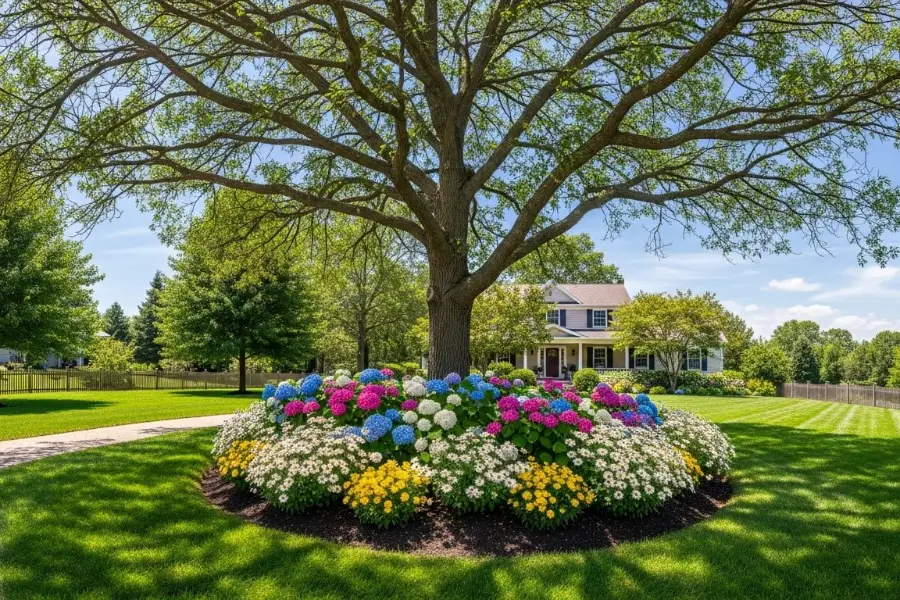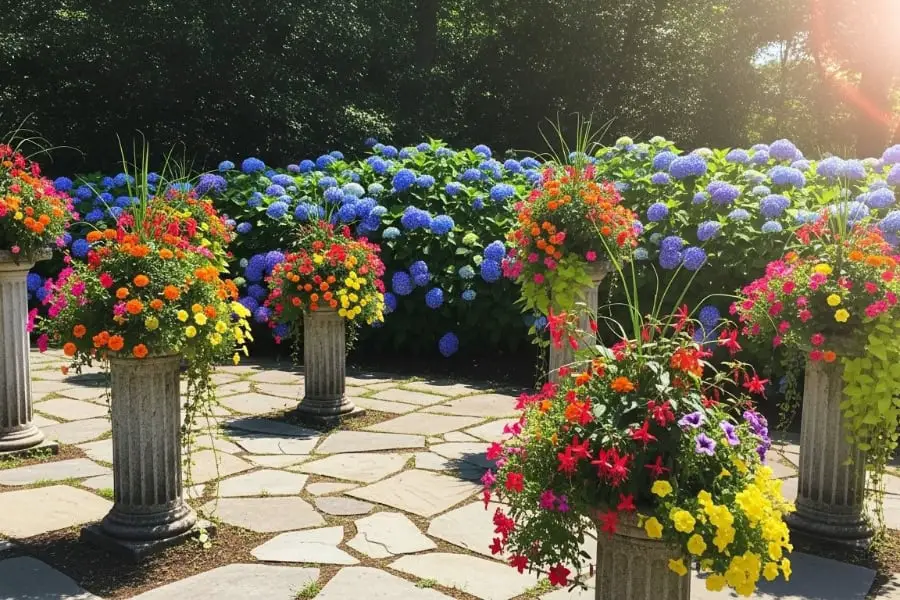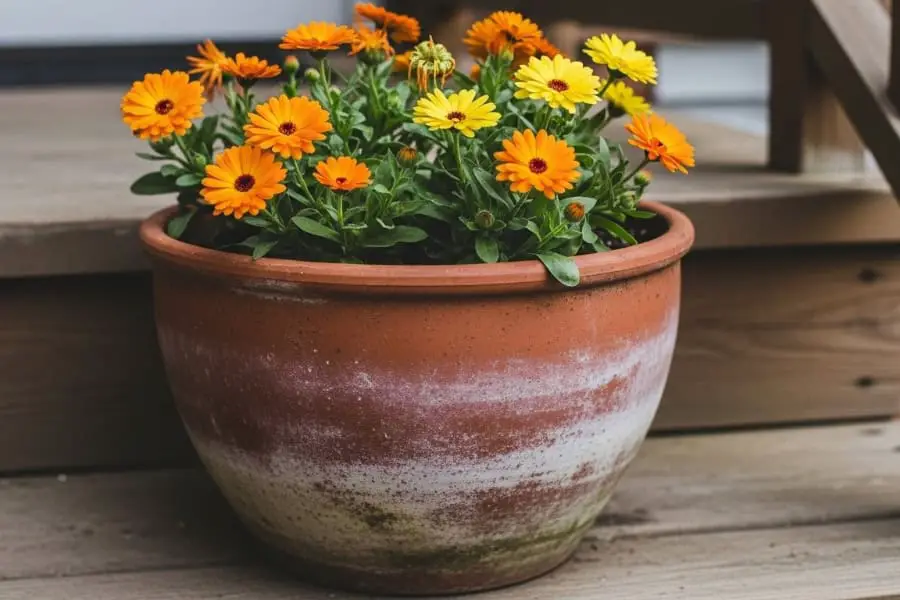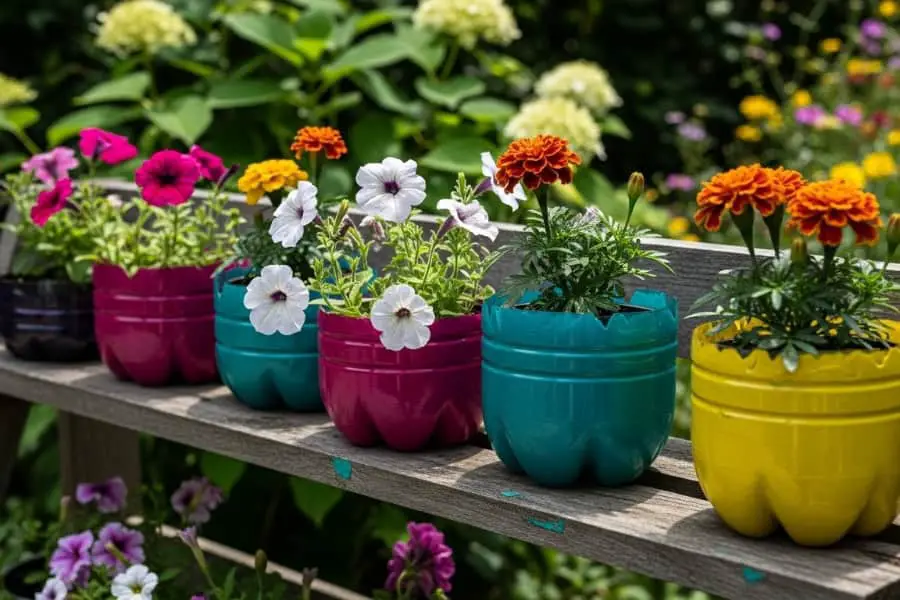
Hi Green Thumbs!
Struggling to keep your garden neat and tidy? It can be tough to stop grass from creeping into flower beds. After some digging around, I discovered helpful garden edging ideas that really work.
These tips can help you create clean borders and boost your yard’s look. Keep reading for creative options!
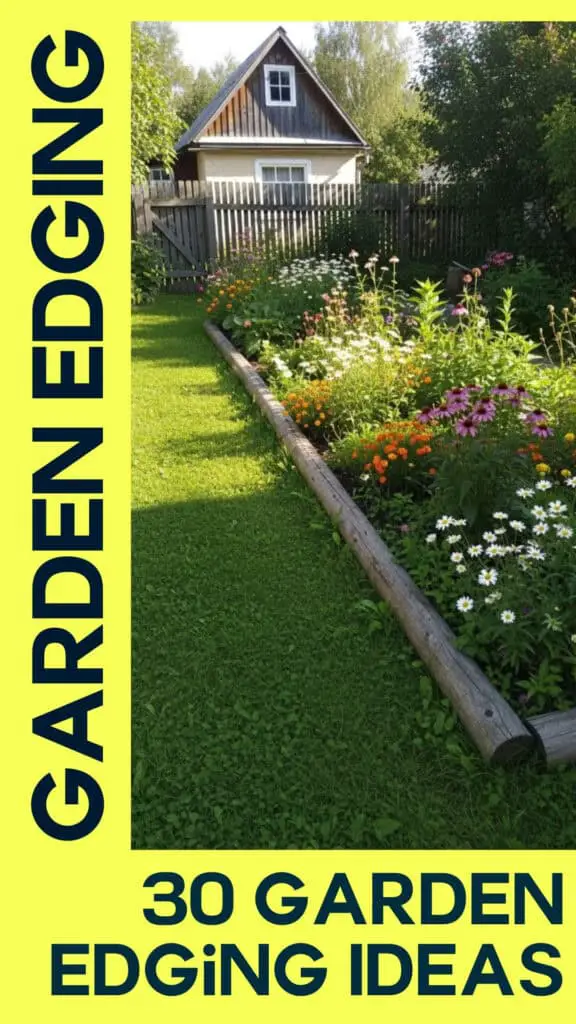
Contents
- 1 34 Garden Edging Ideas
- 1.1 Bamboo
- 1.2 Black
- 1.3 Cement
- 1.4 Cobblestone
- 1.5 Concrete
- 1.6 Curved
- 1.7 Flagstone
- 1.8 Flower
- 1.9 Brick
- 1.10 Lawn
- 1.11 Pond
- 1.12 Hypertufa
- 1.13 Japanese
- 1.14 Log
- 1.15 Modern
- 1.16 Mosaic
- 1.17 Painted
- 1.18 Pallet
- 1.19 Paver
- 1.20 Plastic
- 1.21 Roof
- 1.22 Rope
- 1.23 Rubber
- 1.24 Sandstone
- 1.25 Scalloped
- 1.26 Sleeper
- 1.27 Steel
- 1.28 Stone
- 1.29 Timber
- 1.30 Tropical
- 1.31 White
- 1.32 Willow
- 1.33 Wine Bottle
- 1.34 Wooden
- 2 Conclusion
- 3 FAQs
34 Garden Edging Ideas
Garden edging can change the way your yard looks. From rustic logs to sleek concrete, there’s something for every gardener!
Bamboo
Bamboo edging adds charm and a natural touch to gardens. It uses high-quality Tonkin bamboo poles, measuring L100-H25-30cm.
Each piece has 27 round bamboos strung together and includes one bamboo stake for easy setup.

This lightweight design works well for patios, flowerbeds, or decorative fencing. I like that it offers both grounded and standing styles for flexibility.
Bamboo is eco-friendly, renewable, and a great alternative to wood products. It blends nicely with greenery while enhancing walkways or landscaping projects with rustic appeal.
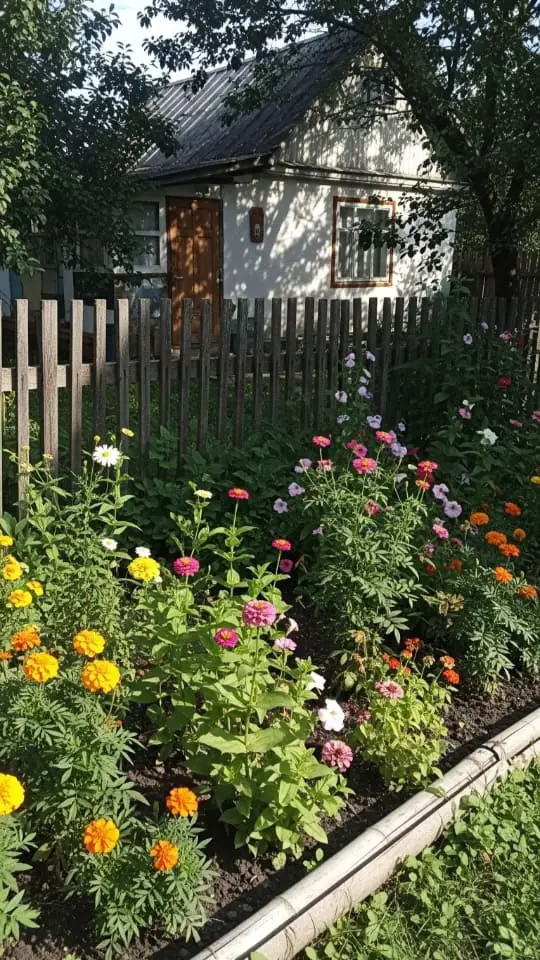
Black
After using bamboo for a natural look, black garden edging feels modern and sharp. I use Vinci Landscape Edging Border in my yard to create sleek lines around flower beds and paths.
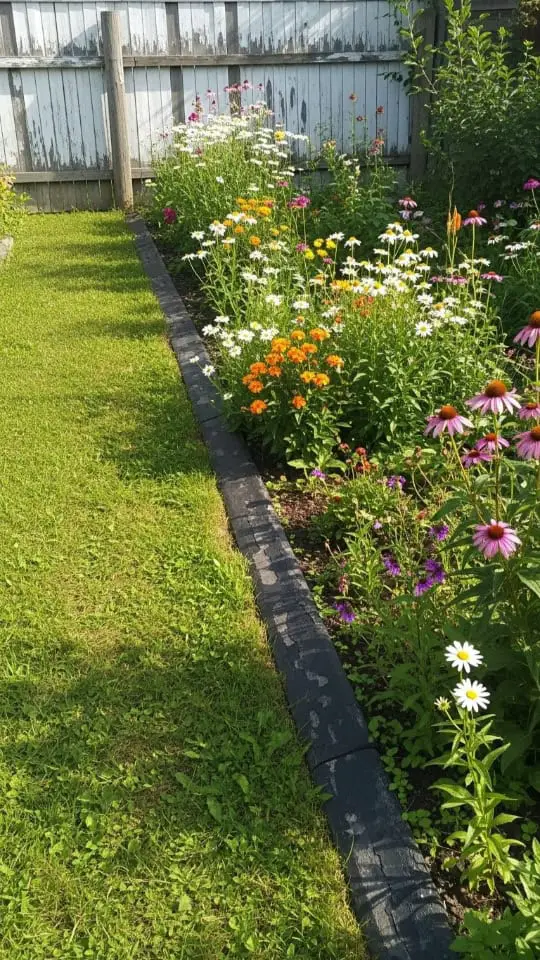
This black galvanized steel edging doesn’t rust or wear down, even after heavy rains. Each pack includes three pieces stretching 10 feet total and weighs just 8 pounds, making it sturdy but easy to handle.

The hook-and-connect system is quick to install with no digging needed! Its dark finish makes gardens pop, perfect for clean landscaping designs or separating mulch from lawns neatly.
Cement
Black edging looks sleek, but cement brings unmatched durability. Cement garden edging stays strong for years, lasting over 12 when installed properly.
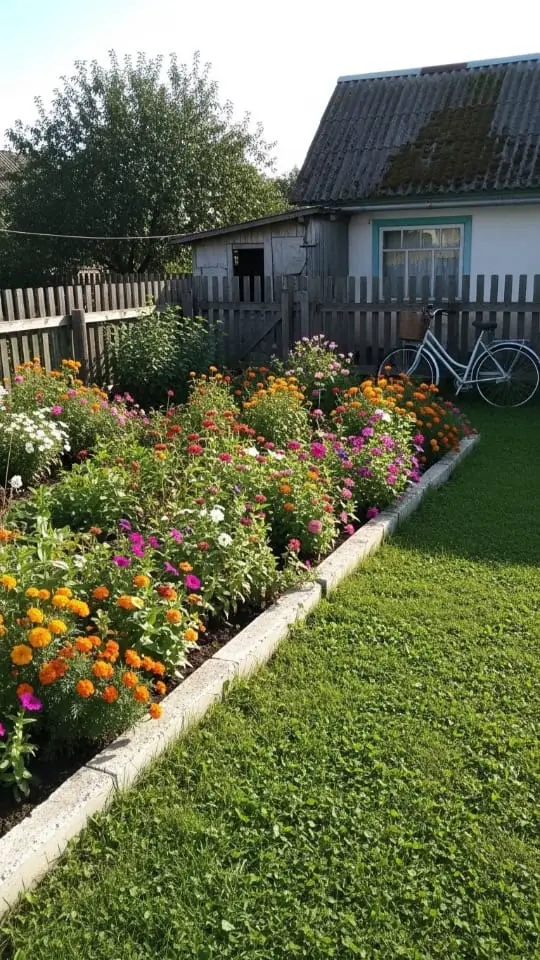
I create clean landscape borders with this low-cost material. A 2-foot section costs just $1.69 to $2.00! I dig a trench, lay the cement pieces in place, and tamp down soil around them using my rubber mallet.
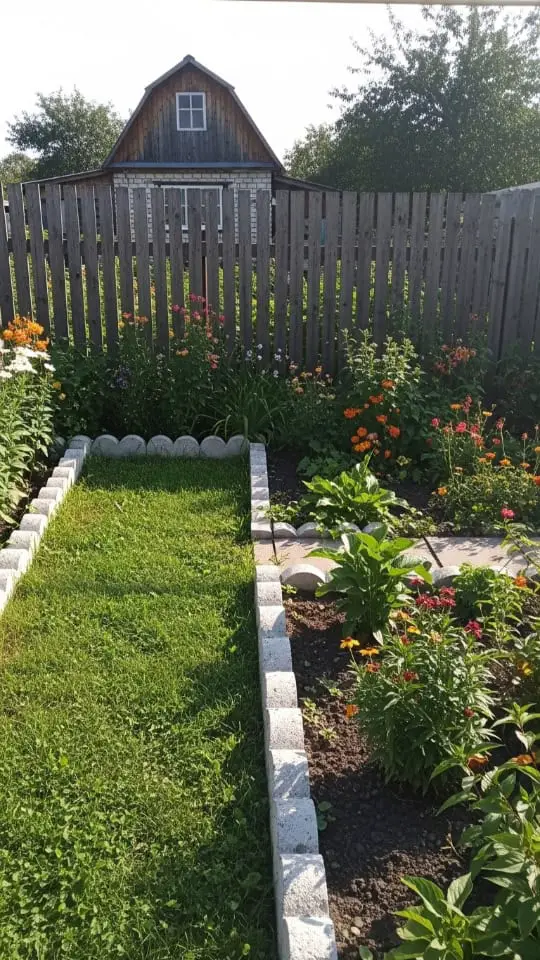
It keeps mulch in, weeds out, and lawns tidy without much upkeep.
Cobblestone
Curved cobblestones add a timeless touch to any garden. I enjoy how they outline beds, creating soft lines that feel natural yet elegant.
These stones help keep mulch in place, even during heavy rains. They work better than plastic since they last for decades with little upkeep.
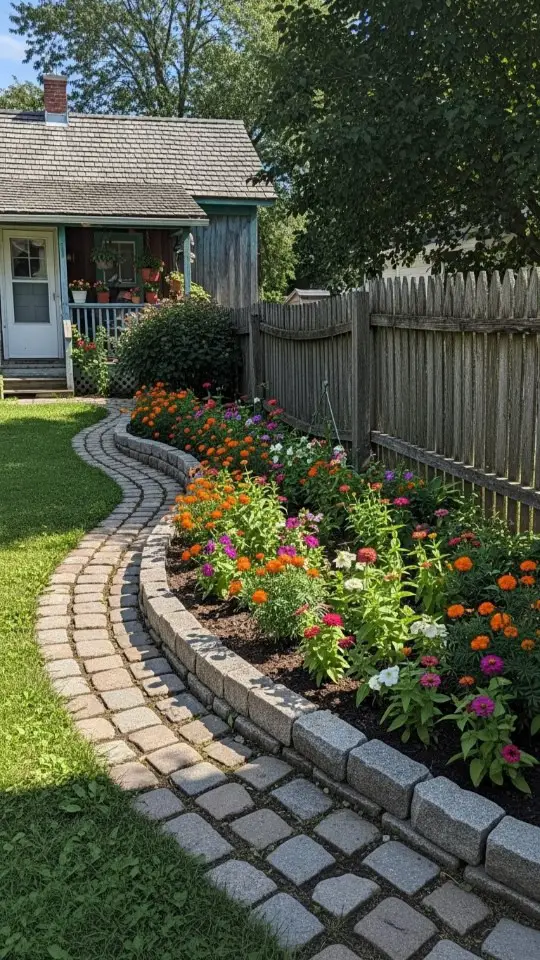
Using cobblestones can boost curb appeal too. Real estate pros say well-edged gardens increase property value.
Plus, they improve both looks and function by neatly separating flowerbeds from walkways or grass areas.
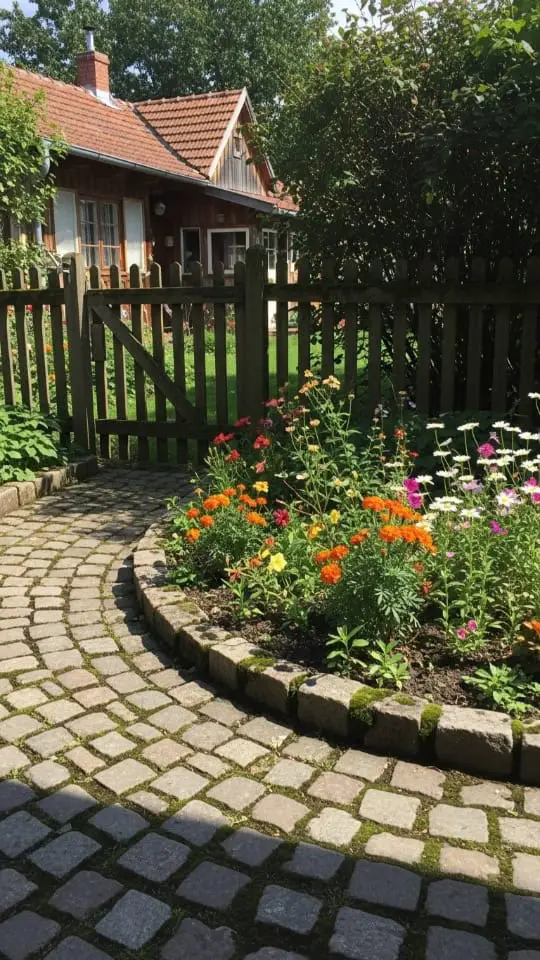
It’s a simple way to enhance a space without constant maintenance!
Concrete
Cobblestones bring charm, but concrete edging brings strength. Solid concrete lasts for years without needing replacement. It stays strong through heat, rain, and most climates.
Freezing weather might cause cracks, though, so I’d avoid it in very cold areas.
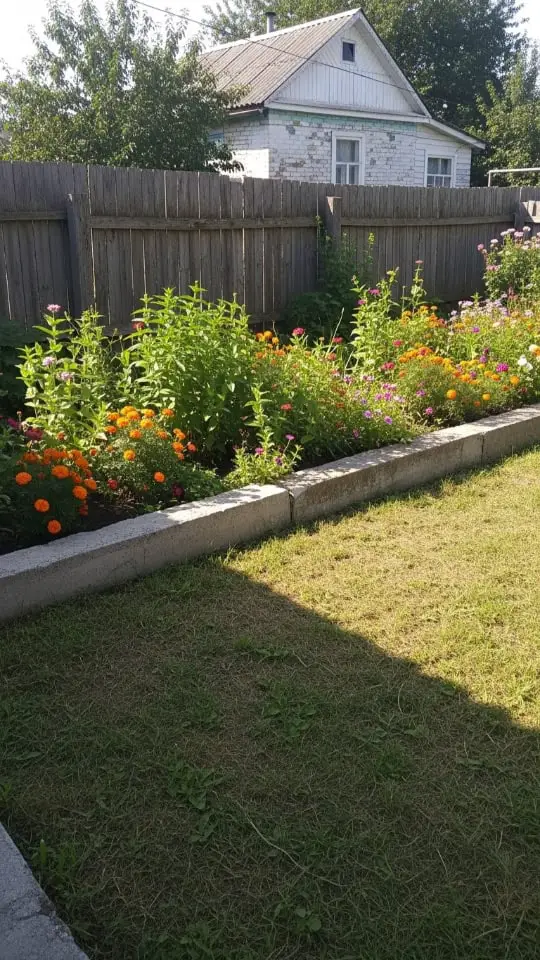
Poured concrete can match any garden style. I like how you can pick different colors or patterns to suit your design.
Its porous surface absorbs water well too; this makes it great near walkways or places with heavy rainfall.

If erosion is a problem in your yard, deeper installation helps keep everything in place. It’s also budget-friendly and looks high-end without costing as much as stone or steel options!
Curved
Curved garden edging adds a soft, natural look to any space. It helps create smooth transitions between flower beds and pathways.
I like how it defines areas without sharp lines, making the yard feel more open and inviting. Curves guide visitors through my garden while keeping plants neatly in place.

Using materials like stone, plastic edging, or timber enhances the style. Matching colors or textures with existing features makes everything flow together beautifully.
Combining curved edges with flowers or mulch containment improves organization too. For me, this option feels low-maintenance but stylish at the same time!
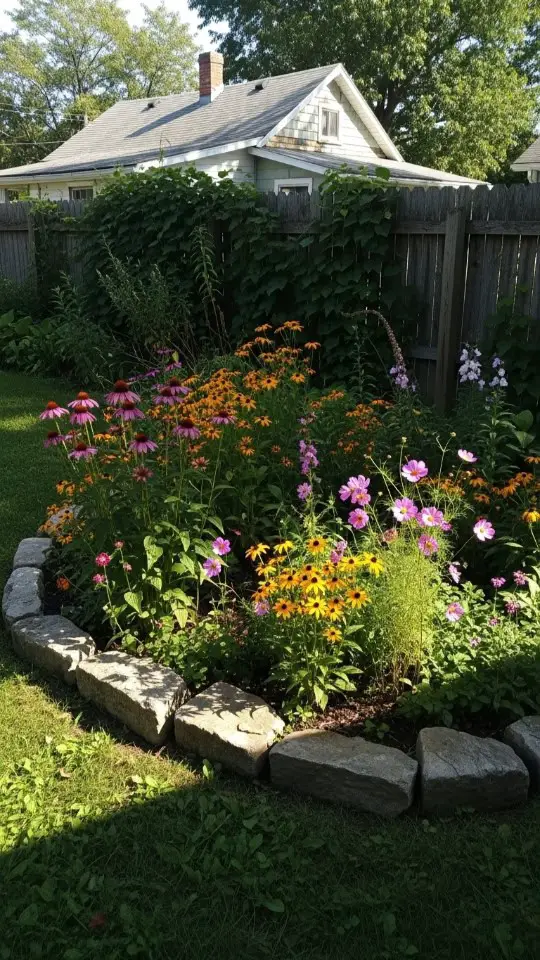
Flagstone
Flat flagstones create a rustic look for garden edges. I like how they define spaces while keeping the design natural.
These stones come in granite, limestone, or sandstone, each adding its own charm. They cost about $5 to over $30 per linear foot, depending on type and quality.
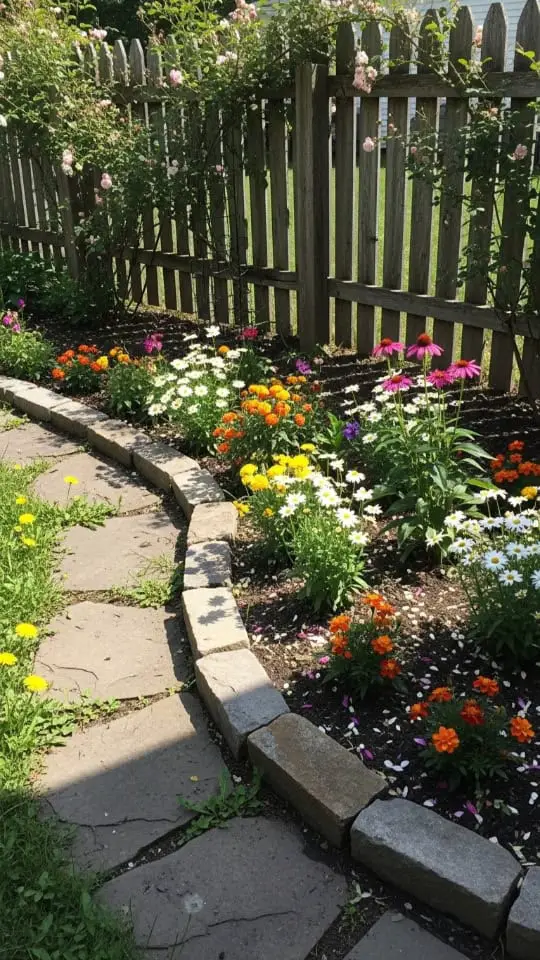
Installing them is simple but takes care. I use a shovel and string line to mark the edge. A rubber mallet helps set the stones securely. Regular checks prevent shifting and keep weeds away.
This edging fits perfectly before moving into flower garden designs!
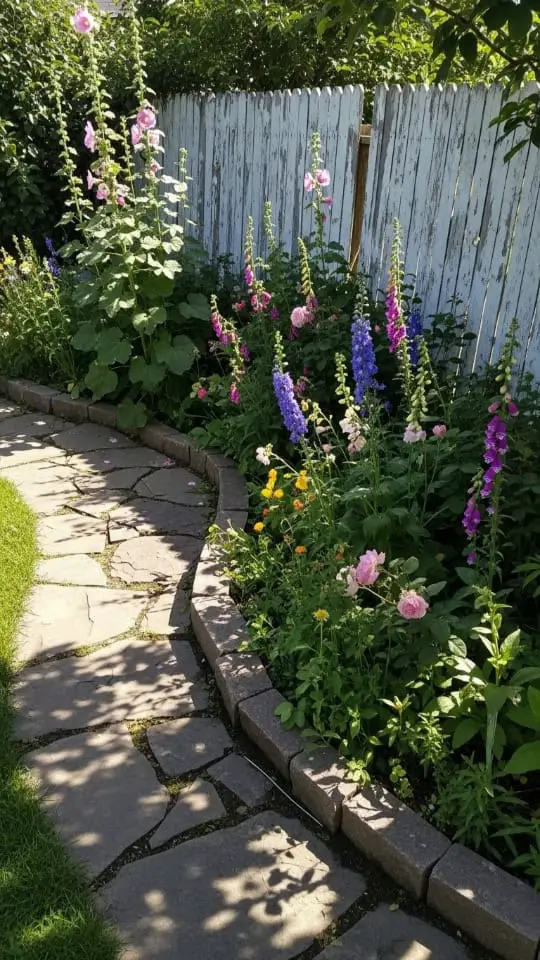
Flower
Flagstones add rustic charm, but decorative flower garden edging brings personality. I love how it turns plain borders into eye-catching frames.
Coco fiber adds a natural touch, while scalloped designs bring elegance.
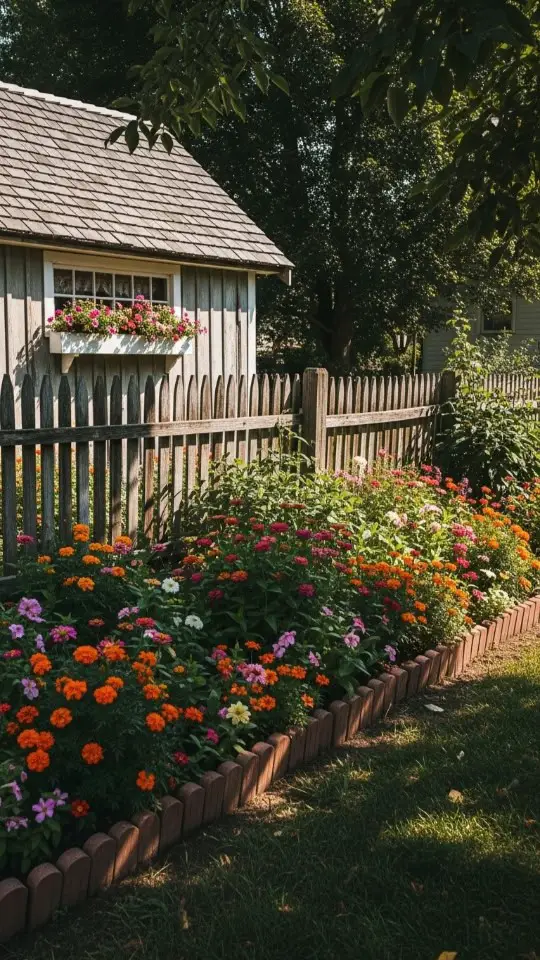
Mixing materials like pavers and river rocks works great too. They keep weeds out and look amazing around bright blooms.
Using recycled rubber edging is another smart option; it’s eco-friendly and flexible for curves.
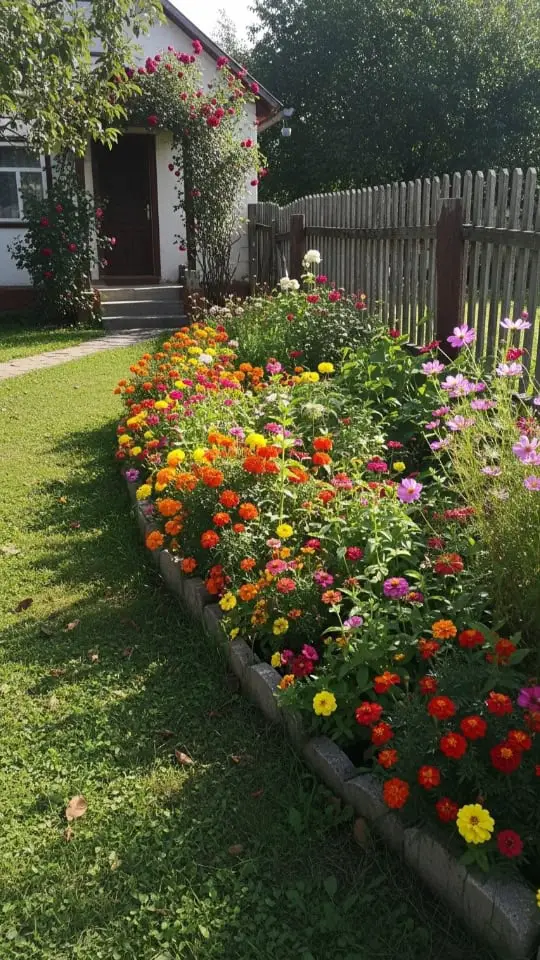
Brick
I like using bricks for garden edging. They make everything look neat and colorful. Stacked bricks create strong borders that keep grass from creeping into flower beds.
I often go with a double row of bricks for extra sturdiness. The structure also adds charm to my yard.
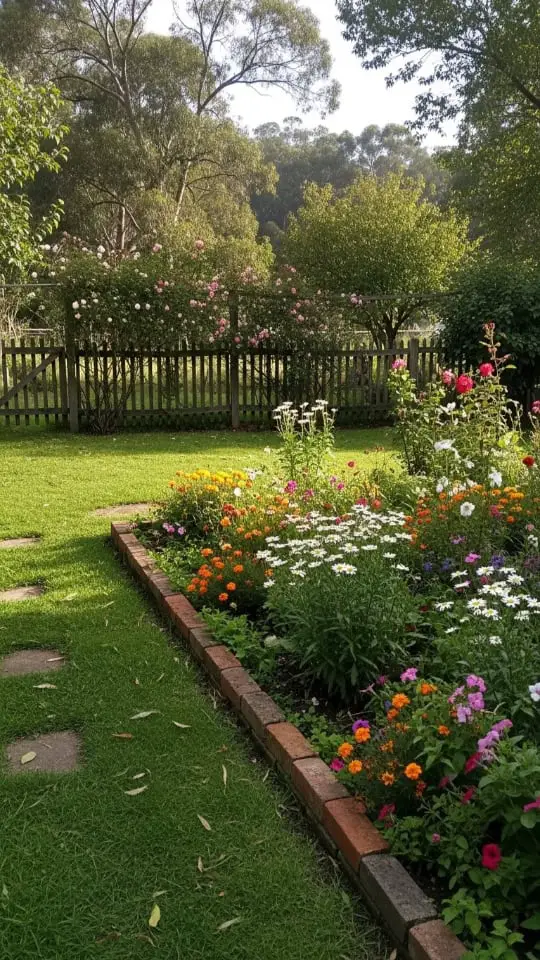
Bricks work well in most climates, but soil type matters too. For areas with heavy rain or shifting ground, I ensure the base is solid before stacking.
A rubber mallet helps me position the pieces snugly in place without breaking them. Bricks are low-maintenance and last a long time if set up correctly!
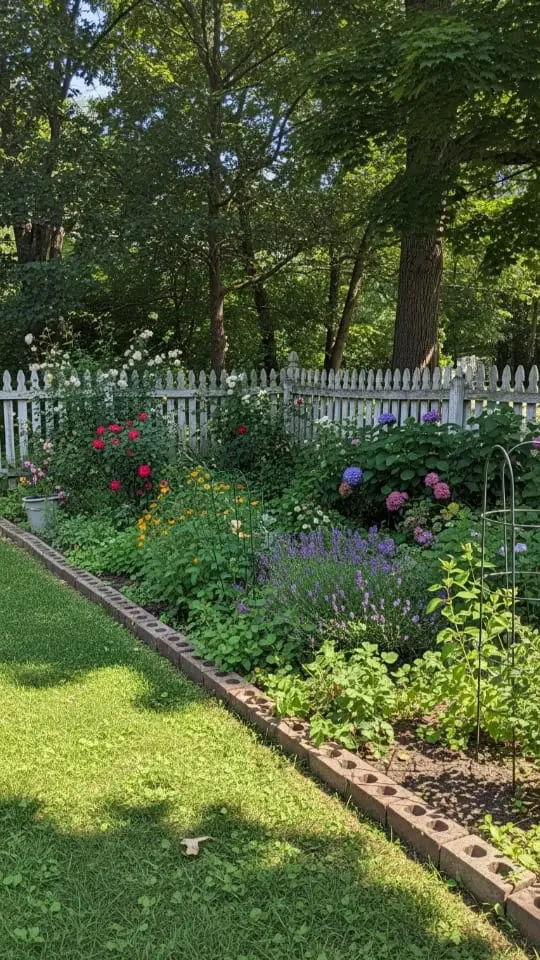
Lawn
Clean edges make the garden look neat. Lawn edging defines spaces, keeping grass away from flower beds. It gives a polished and professional appearance to any yard.

I use simple tools like an edging shovel or rubber mallet for this job. Strong materials such as stone, metal edging, and even plastic edging work well.
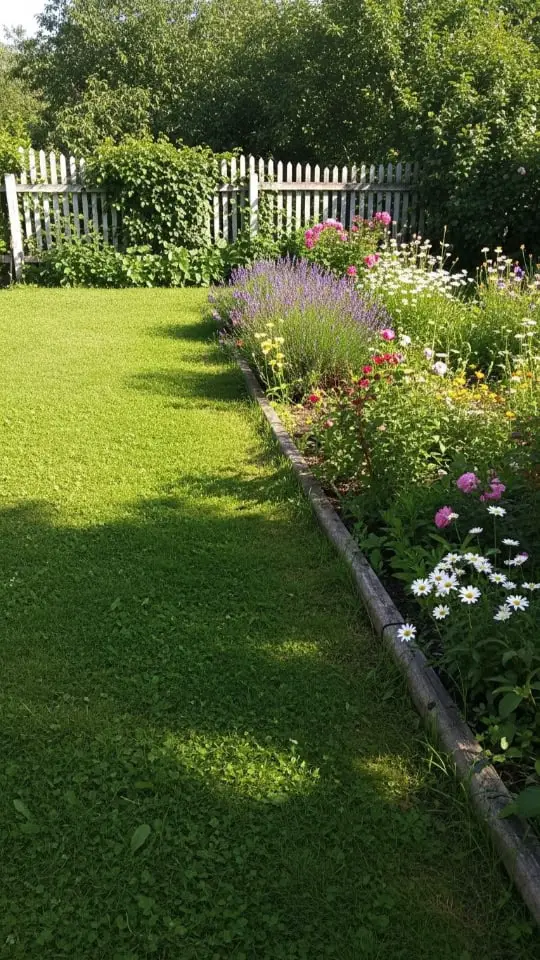
These options contain mulch and prevent weeds too! Good lawn edges upgrade the whole outdoor space while staying low-maintenance.
Pond
Natural stones like pebbles and rockery fit perfectly around ponds. They blend well with plants, making the area feel calm and natural.
Using partially submerged rocks adds depth and a smooth look to the edges.
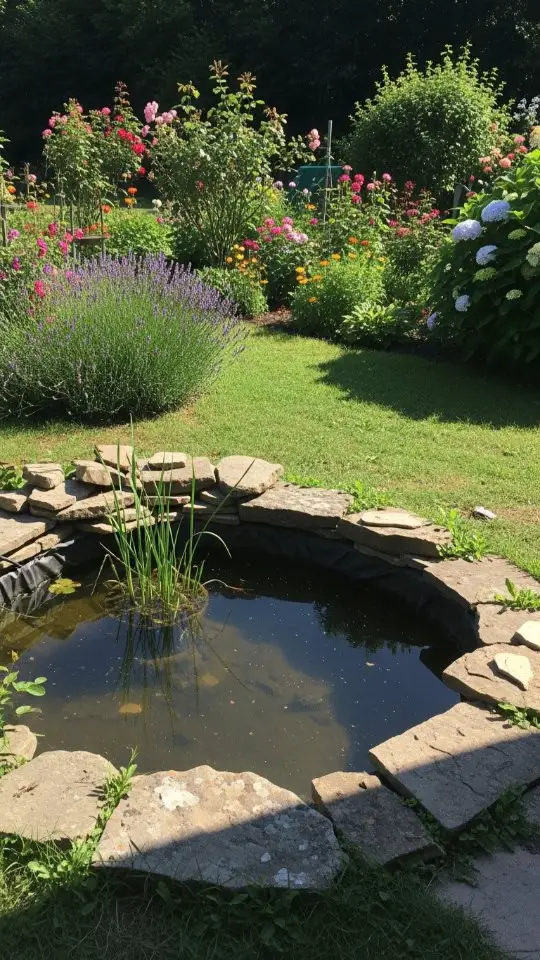
I avoid sharp materials for safety, especially near water features. I also like planting greenery close to the stone edging.
This creates a seamless flow between plants and the pond’s edge, tying everything together beautifully.
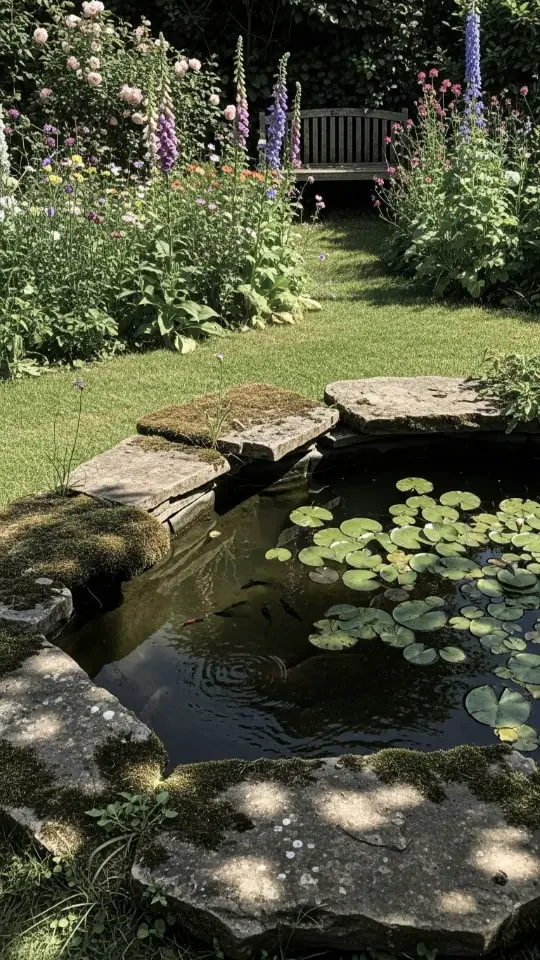
Next up is hypertufa garden edging!
Hypertufa
Hypertufa blocks give gardens a textured, rock-like border. They look like real stone but are lighter and easier to handle.
I find them simple to install since they don’t weigh as much as real stones or concrete. Their durability makes them perfect for any weather without cracking or wearing out.
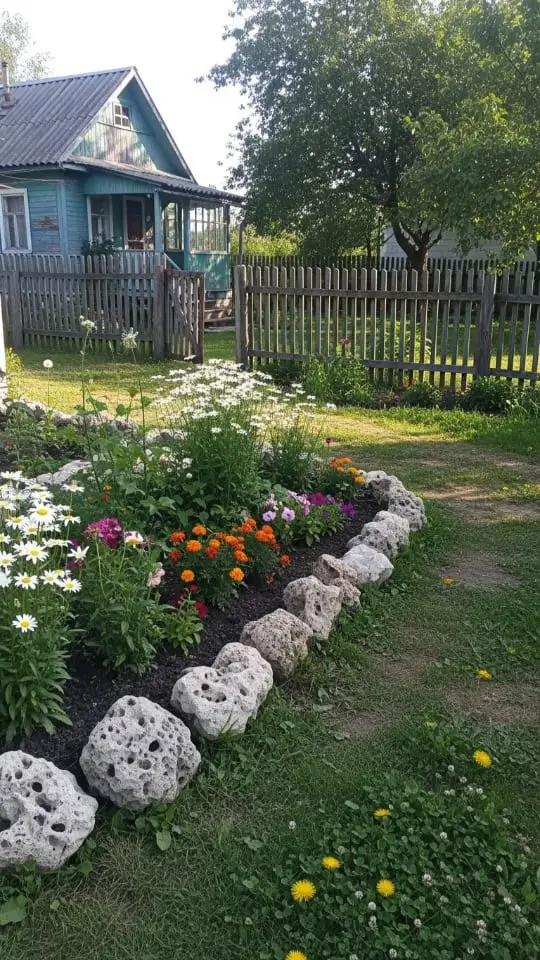
I love that hypertufa edging allows for creativity. The blocks come in custom shapes, letting me design unique borders around flower beds and pathways.
Using these blocks helps with mulch containment too! Plus, they add a rustic charm while being budget-friendly compared to heavy stone materials.

Japanese
Bamboo edging brings calm and beauty to a garden. I love how bamboo strips add a natural, soft border along paths.
They create flow that feels peaceful, perfect for Japanese garden designs.
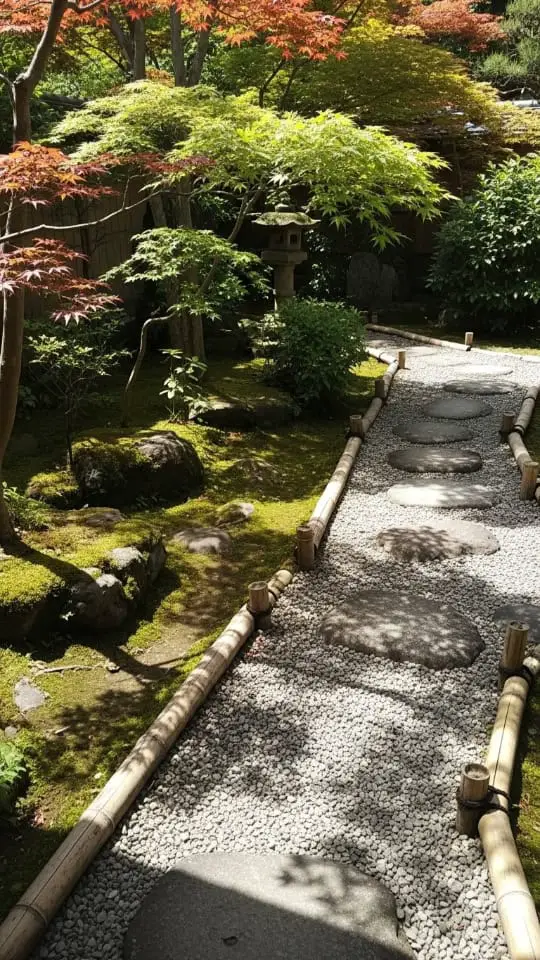
The bamboo pieces can be cut at different heights for visual interest. By tying them together with string, they stay smooth and neat over time.
This low-maintenance edging fits well with mulch containment or flower beds too!
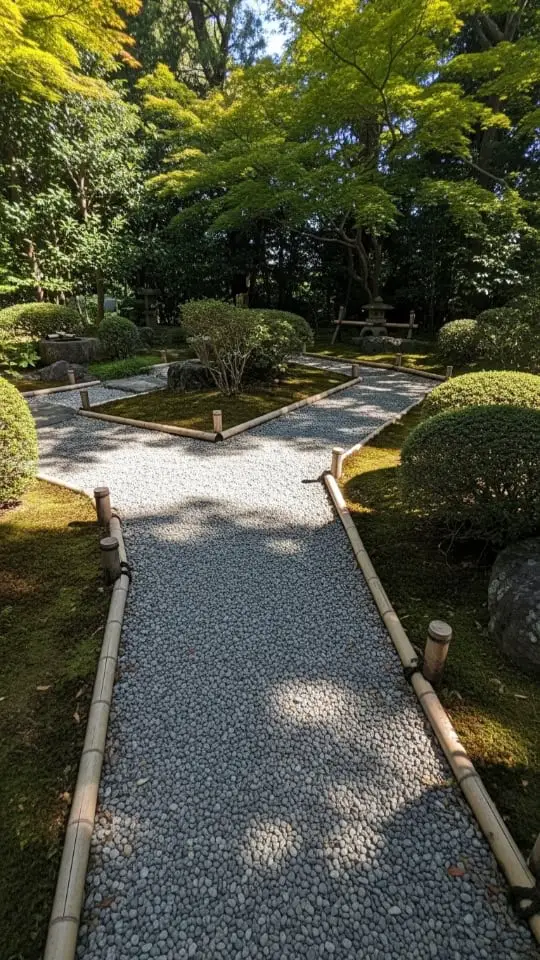
Log
I like using fallen trees for edging. They make my garden look natural and simple. Logs frame flower beds or pathways well.
I pick sturdy, untreated wood to avoid chemicals seeping into the soil.
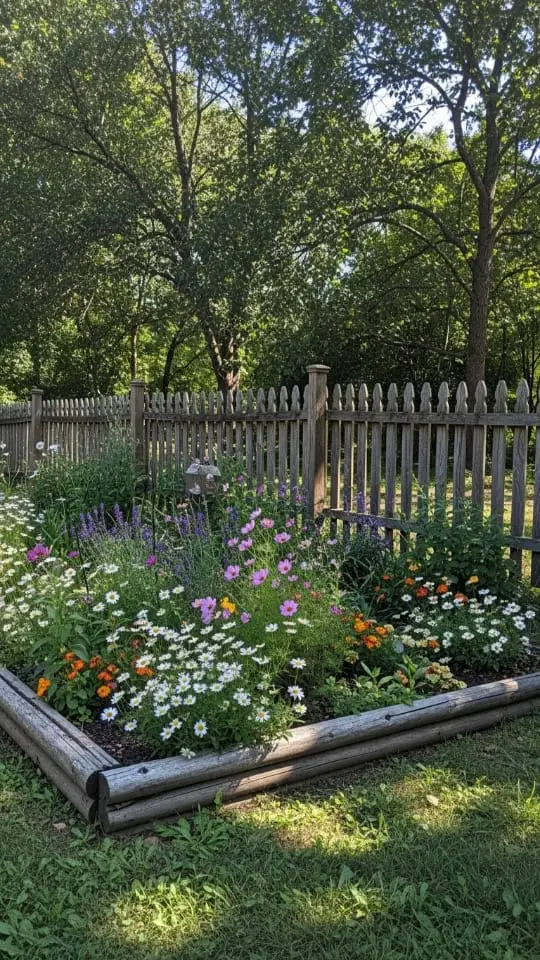
Sometimes, I let wildflowers grow around woven log borders. It feels like nature’s own design! Infested logs can add a rustic touch too (as long as pests won’t spread).
This type of edging fits gardens with a wild or earthy theme perfectly.
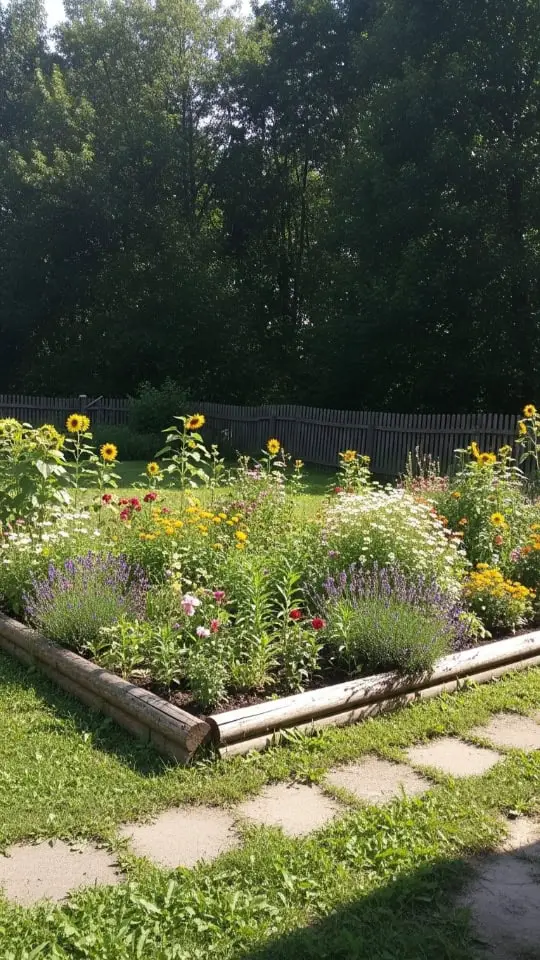
Plus, it’s free if you have branches lying around!
Modern
Logs give a rustic touch, but concrete brings sharp, modern vibes. Concrete edging forms straight lines that add a clean look to any garden.
It works as a mini retaining wall, keeping mulch and soil in place.
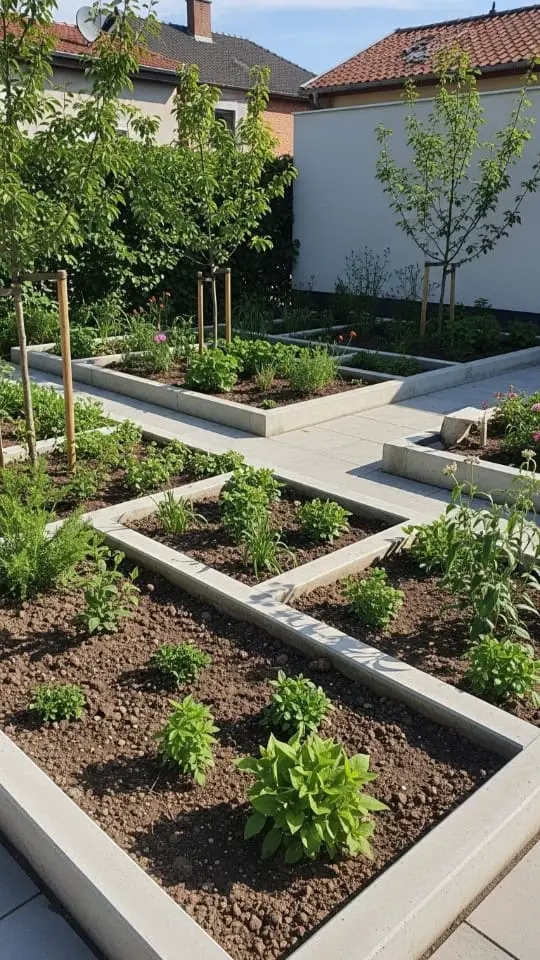
Using poured concrete ensures durability while framing flower beds with style. Mixing it with stone or metal creates sleek zones for plants or paths.
Its low-maintenance nature makes it perfect for busy gardeners who want neat spaces without much effort.
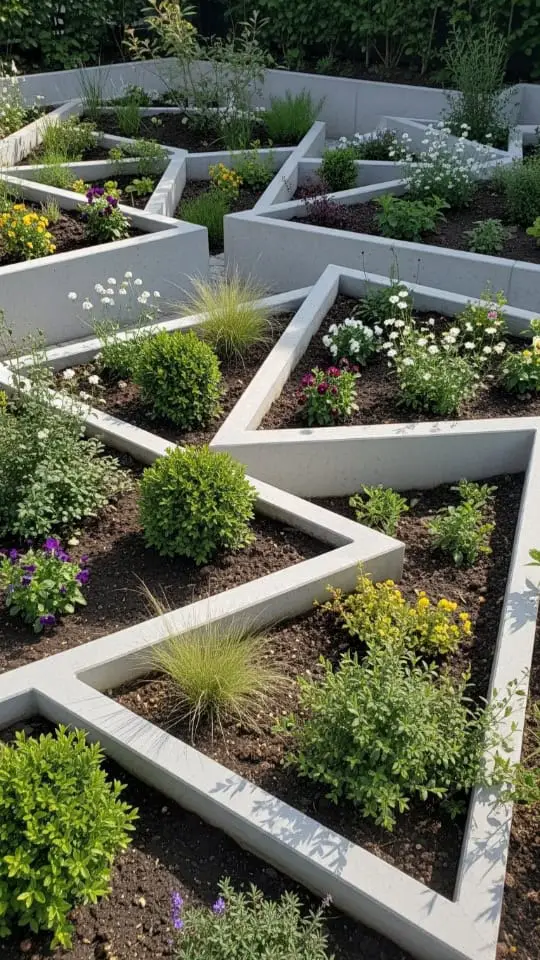
Mosaic
I love using mosaic garden edging to make my borders vibrant. Broken tiles or mosaic pieces work well for this. I’ve seen floral designs and geometric patterns that look so artistic.
It’s also a fun DIY project, letting me create something unique.
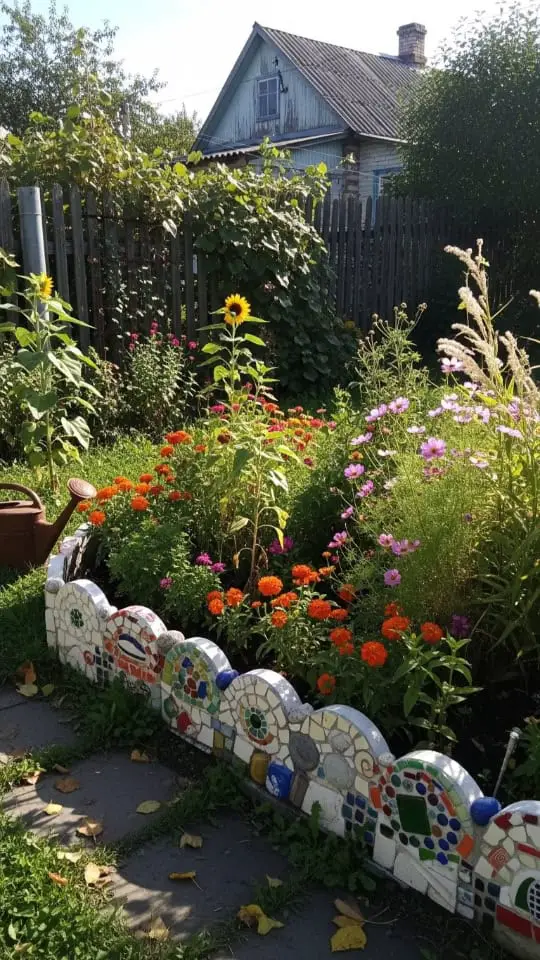
These mosaics can wrap around ponds, tile fountain bases, or even birdbath pedestals. The bright colors and patterns bring life to the garden.
They stand out beautifully against greenery and flowers while adding a personal touch.
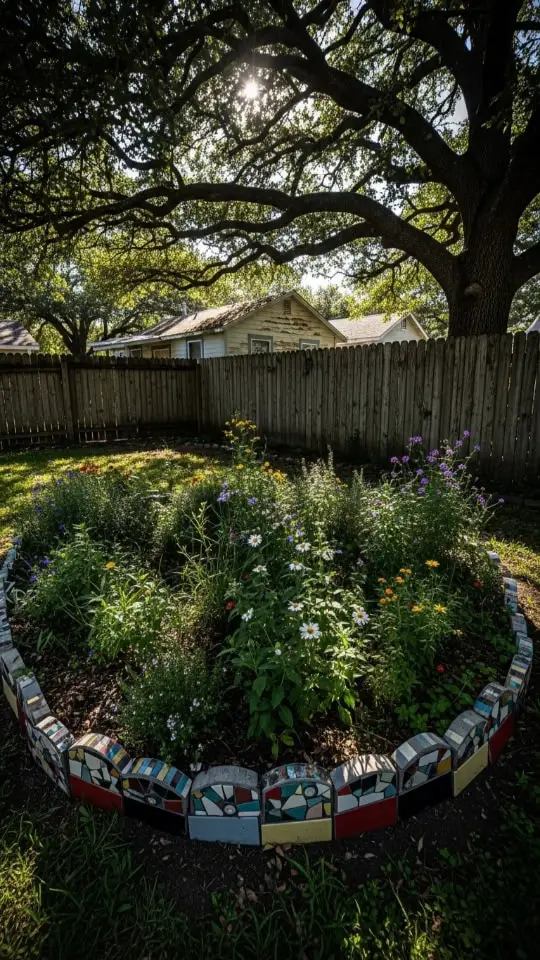
Painted
Brightly painted edging turns plain garden borders into eye-catching features. I use untreated 2×4 lumber and coat it with exterior-grade paint.
This gives a bold, colorful look that blends with sheds or other structures, like a blue shed nearby.
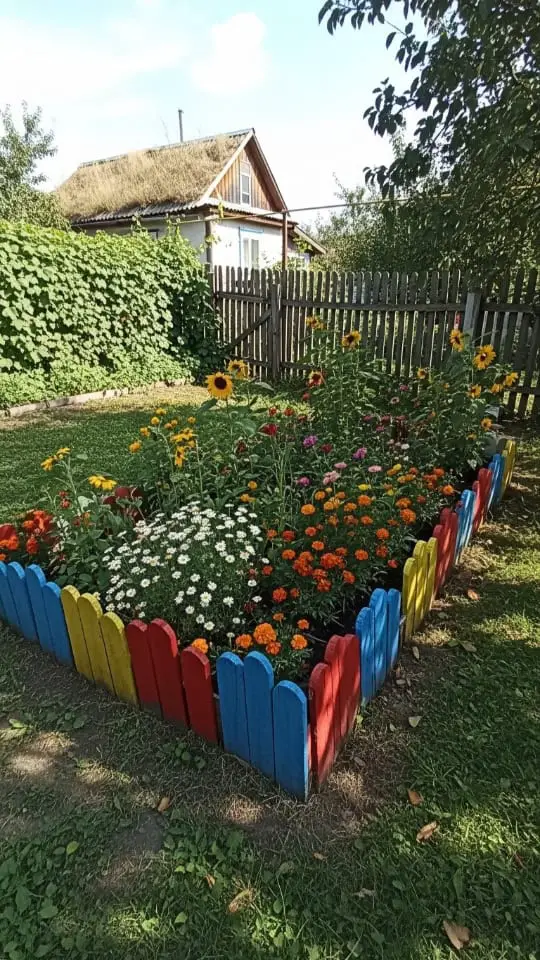
These smooth edges keep the design neat while adding lively color to flower beds. Painting or staining offers more flexibility compared to traditional materials.
It’s an easy way to create low-maintenance edging that feels modern and creative.
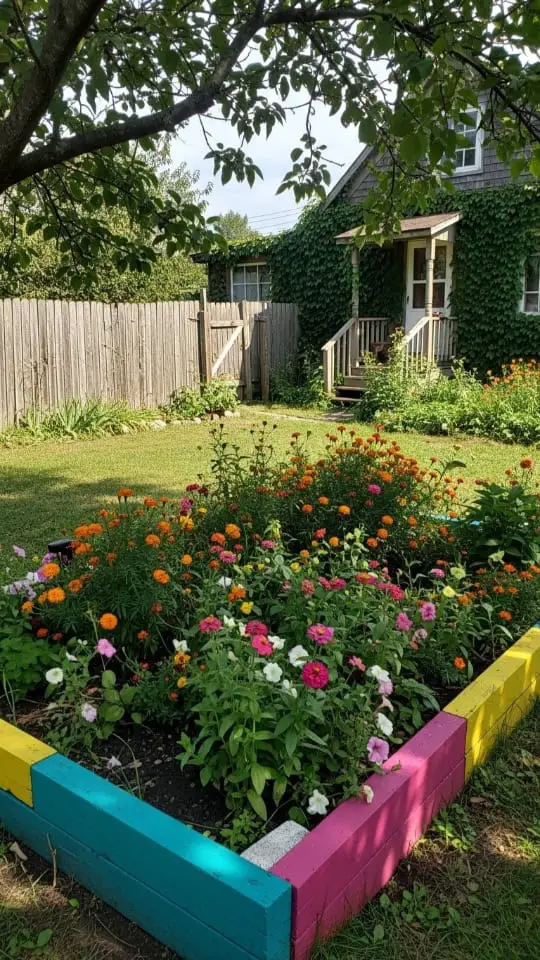
Pallet
Painted borders can pop with color, but pallets offer something unique. I saw a post in the “Creative Gardening” group where Liz Mash shared her pallet edging idea.
It was a hit! Over 461 reactions and 52 comments poured in.
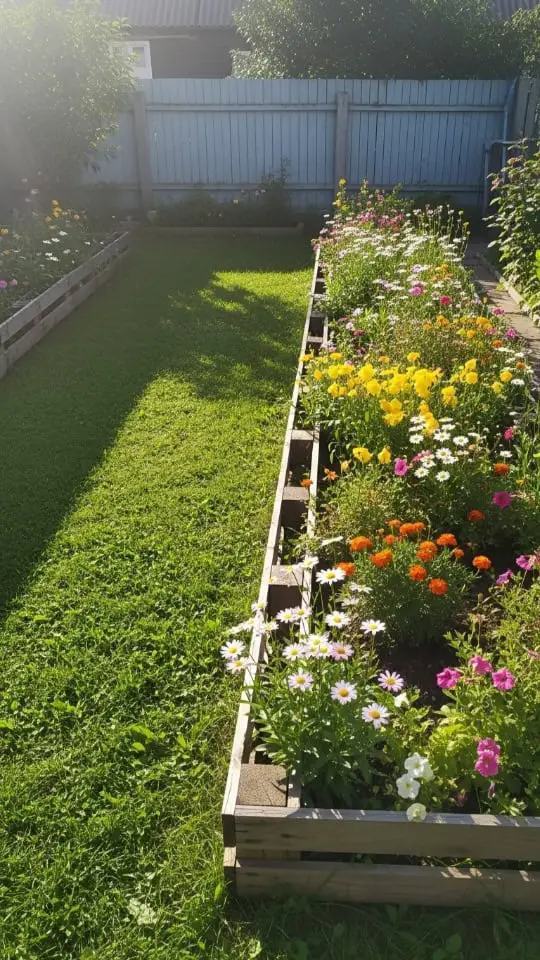
Using old pallets creates rustic charm. I love how easy they are to repurpose into garden borders. The wood adds texture while keeping it eco-friendly.
Plus, it feels great upcycling materials instead of tossing them out.
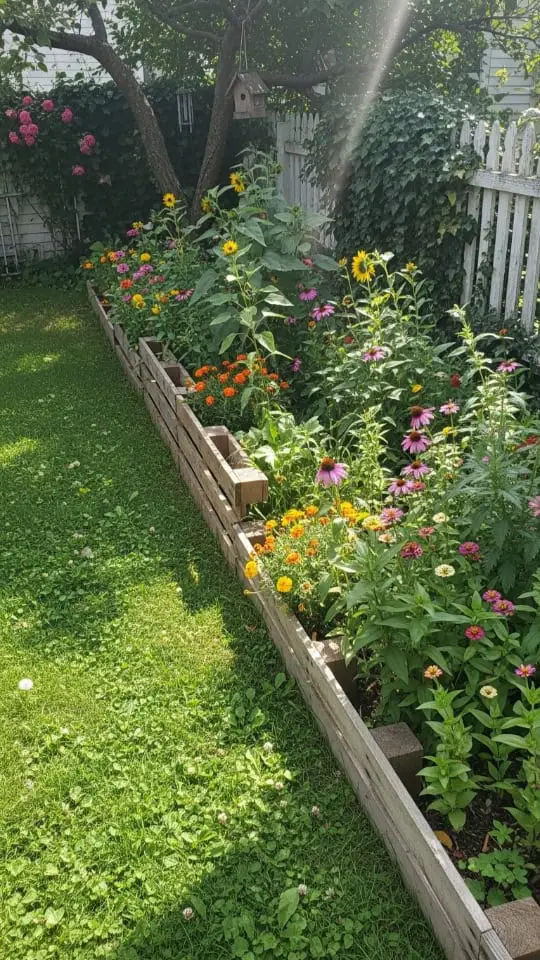
These simple wooden slats give strong mulch containment too. A sturdy option for decorative edging with style!
Paver
Paver garden edging adds a sleek and structured look to any yard. I use it to keep mulch, soil, or gravel in place.
Pavers also help stop erosion and prevent weeds from creeping into flower beds. They stay put over time too, which means less work for me.
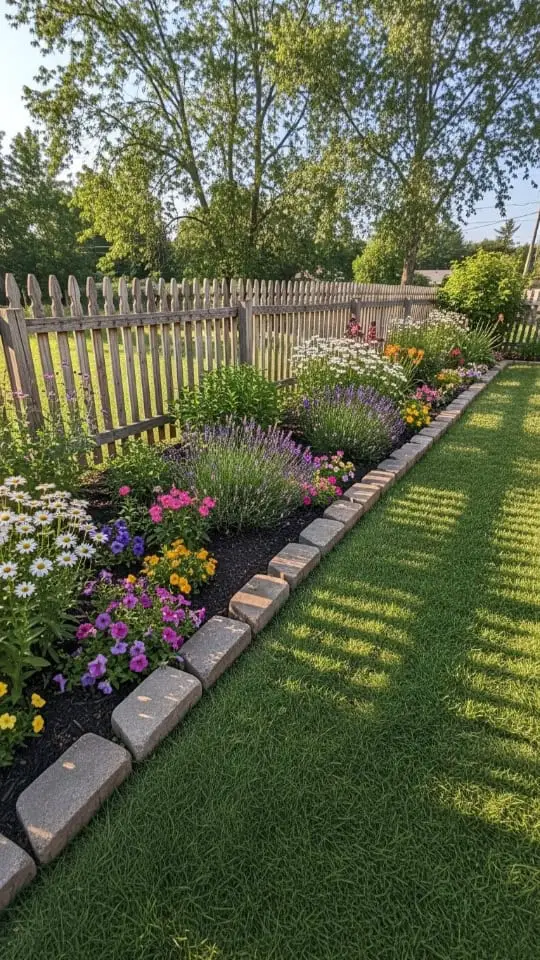
Materials like concrete, brick, or natural stone make pavers sturdy. Straight-edge designs give my garden a modern touch that I love.
Regular cleaning keeps them neat; sealing protects them from weather damage. This low-maintenance option blends well with patios or walkways next to the garden beds.

Plastic
Plastic garden edging is a low-cost way to create neat borders. I like how it bends easily, making curves simple to form around flower beds.
It’s much cheaper than metal or stone options but still gets the job done.

It holds up well against sun and rain, so I don’t worry about replacing it often. Installing it takes just a weekend with basic tools like an edging shovel and rubber mallet.
The clean lines give my yard a polished look that lasts. Plus, it’s lightweight and easy to move if needed!

Roof
I used old roof tiles to edge my garden beds. They gave the borders a neat, curved look and added charm. Richard Telford once reused 750 concrete tiles for raised beds, so I thought I’d try it too.
These tiles hold moisture, which helps plants grow better.

I placed them firmly in the soil for stability against rain or flooding. To keep weeds away and lock in water, I added a thick mulch layer around the edges.
The raised shape even catches more rainwater for deep root growth! Next up? Let’s talk about rope edging with its unique style!
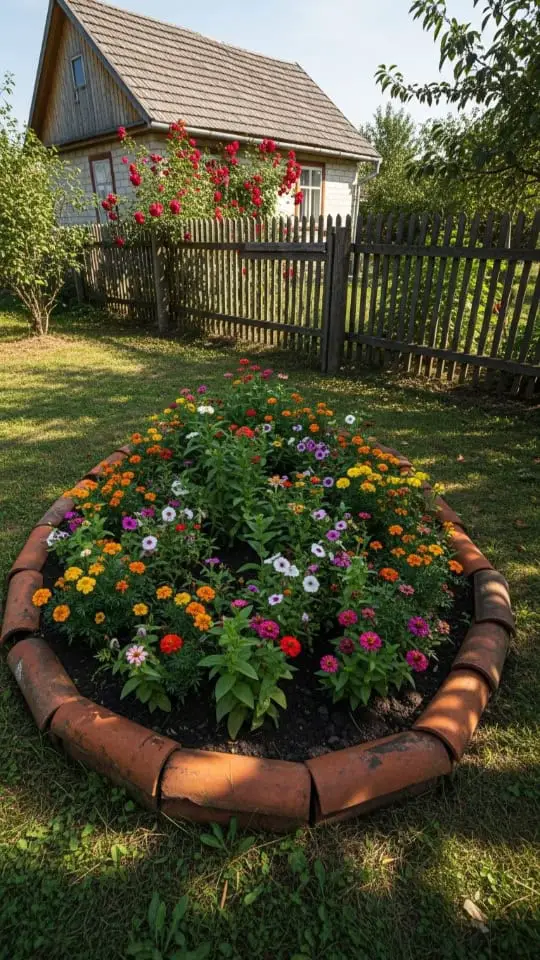
Rope
Thick rope edging gives garden beds a rustic and fun look. I like how it wraps around wooden stakes, creating soft curves along the borders.
It adds charm without taking over the garden’s beauty.
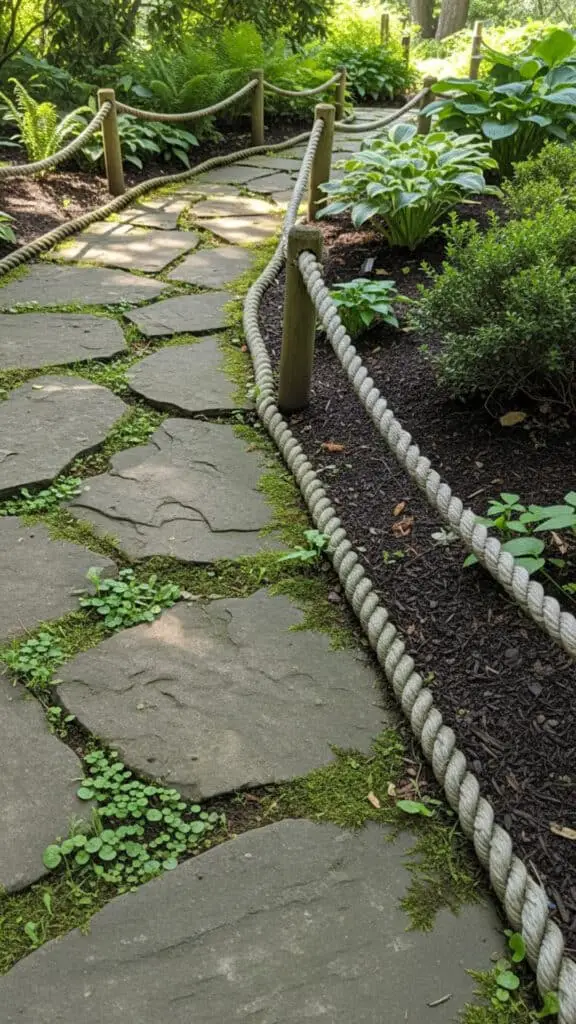
It works well for informal or whimsical designs. It’s not as strong as stone or cement, but it’s affordable and easy to set up.
Using simple tools like an edging shovel can help secure the posts in place. This option feels natural while keeping paths neat and tidy.
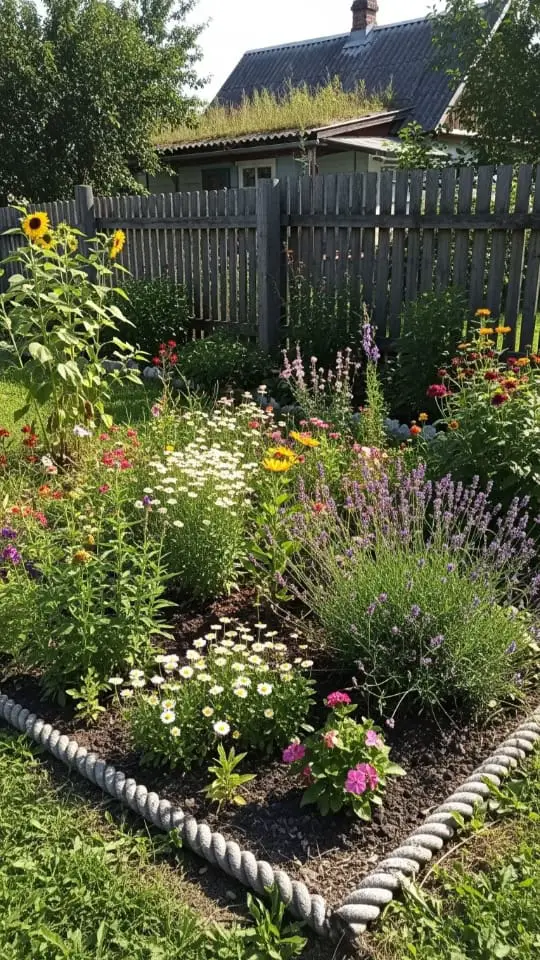
Rubber
Rope edging adds a unique charm, but rubber edging brings flexibility and safety. I use recycled rubber edging in my garden because it works well for all landscapes.
It’s soft but strong enough to keep everything tidy.
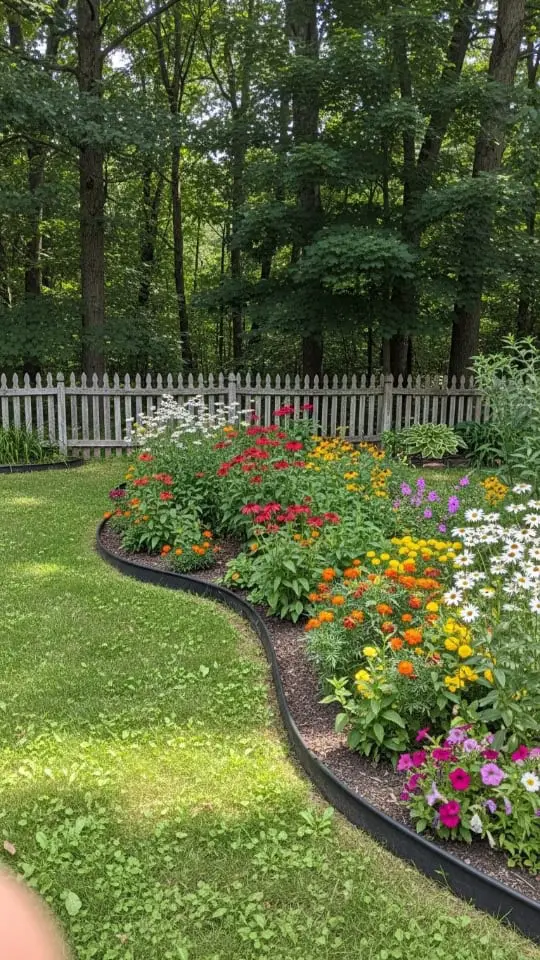
The EcoBorder 4 ft. Red Rubber Landscape Edging comes in handy six-packs with all hardware included for easy setup. No digging is needed, which makes installation quick.
Vigoro’s design keeps mulch in place and reduces maintenance work. If something isn’t right, I can return it within 90 days at the store or online!
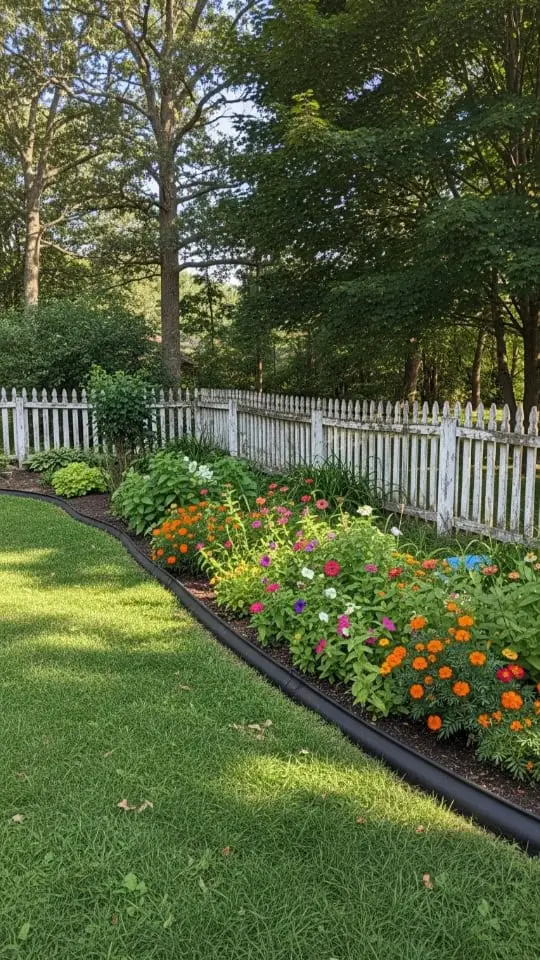
Sandstone
Rubber edging works great for safety, but sandstone adds a timeless touch. Sandstone blocks come in warm tones like buff, beige, gold, rust, and rose.
These natural colors blend beautifully with plants and mulch. The soft veining on the stone gives each piece character without being too bold.
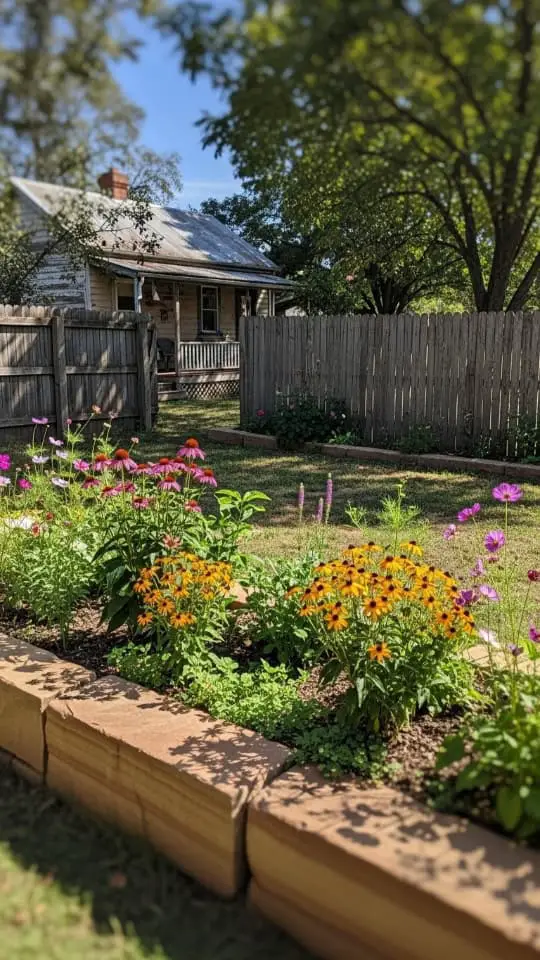
I like that sandstone is easy to handle compared to granite. It’s durable too, lasting 15 to 30 years with little upkeep.
Pairing it with gravel or wood mulch creates an earthy vibe I love in my garden beds.
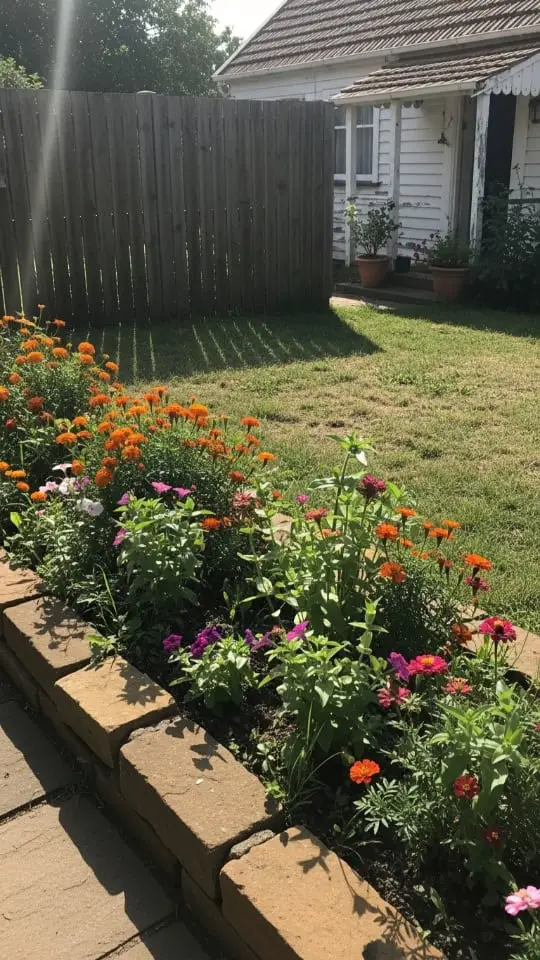
Heights range from 100mm to 300mm, giving plenty of options for custom borders or stacked designs!
Scalloped
Sandstone edging feels warm and natural, but scalloped garden edging gives a decorative touch. I love how the curved scallops remind me of a little village fence.
Patricia Hoffman from Inverness, FL shared this idea, and it caught attention with 25 reactions online. Her design brought charm to flower beds in her yard.
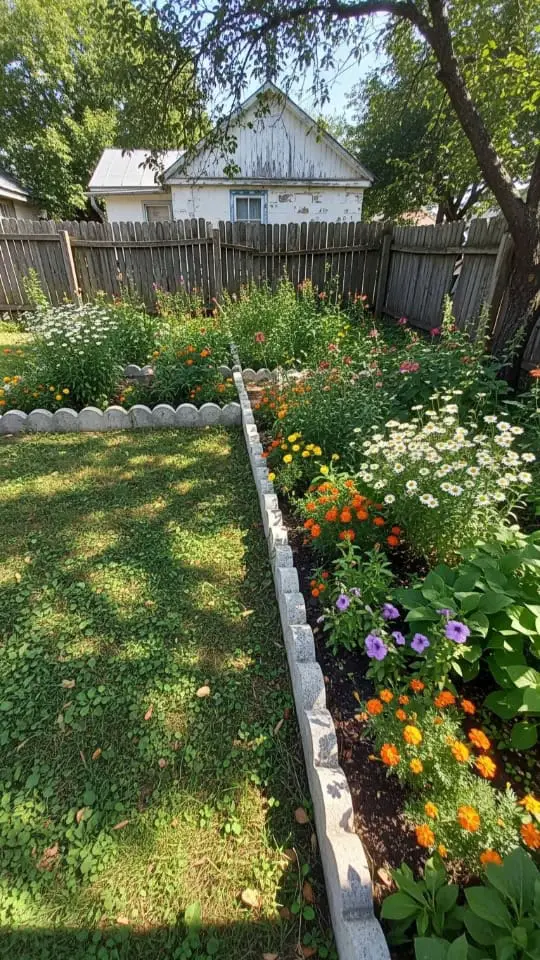
Scalloped borders work great for mulch containment or separating flowers from pathways. They are low-maintenance too!
The curves guide the eye beautifully around beds, making everything look clean and neat. Using them adds both style and function to any landscape edging project.

Sleeper
Scalloped edges bring charm, but sleepers add solid rustic appeal. I like using timber sleepers because they are sturdy and stylish. Treated pine stays strong and resists rot for years.
It’s budget-friendly too, which makes it practical for larger spaces.

Red gum sleepers stand out with their rich color and natural toughness. They are perfect for raised garden beds or decorative border edging.
I always seal them to protect the wood from moisture and sun damage. This simple step keeps them lasting even longer in my yard!
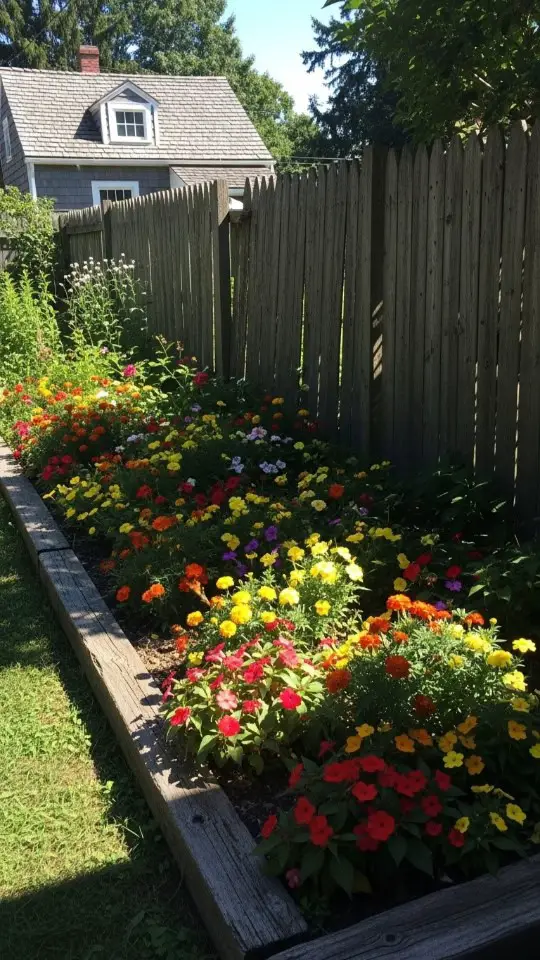
Steel
Steel garden edging lasts for years and handles tough weather. I like how it creates sharp, clean borders that give my garden a modern look.
Decorative options can add extra flair, making it both useful and stylish.
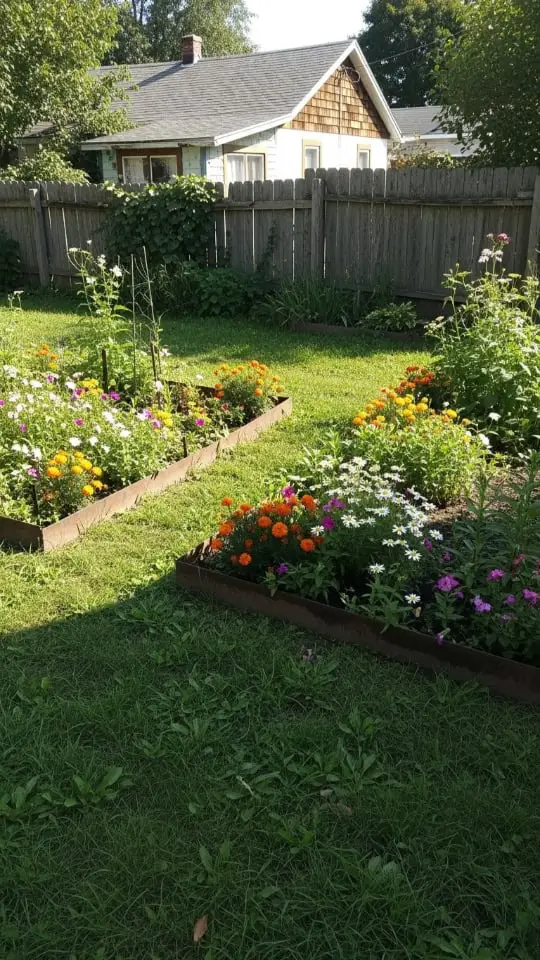
It works well for keeping mulch in place and separating plants from the lawn. The strong metal helps keep weeds out too.
Setting up is simple with an edging shovel or rubber mallet, saving me time on maintenance later.
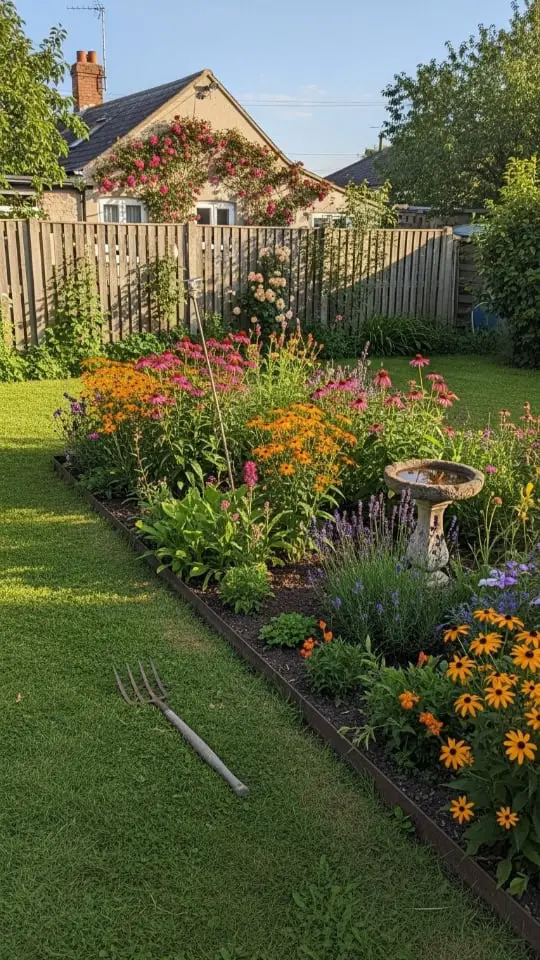
Stone
Stone edging adds natural beauty to a garden. I like how it creates clean lines and helps keep soil and mulch in place.
Natural stones are durable, low-maintenance, and come in many colors to match any style.

Installing stone edging is easy with a gravel base for stability and drainage. The stones stay secure while handling rain or watering.
This type of landscape edging also reduces soil erosion over time, making it both practical and attractive in my yard design!
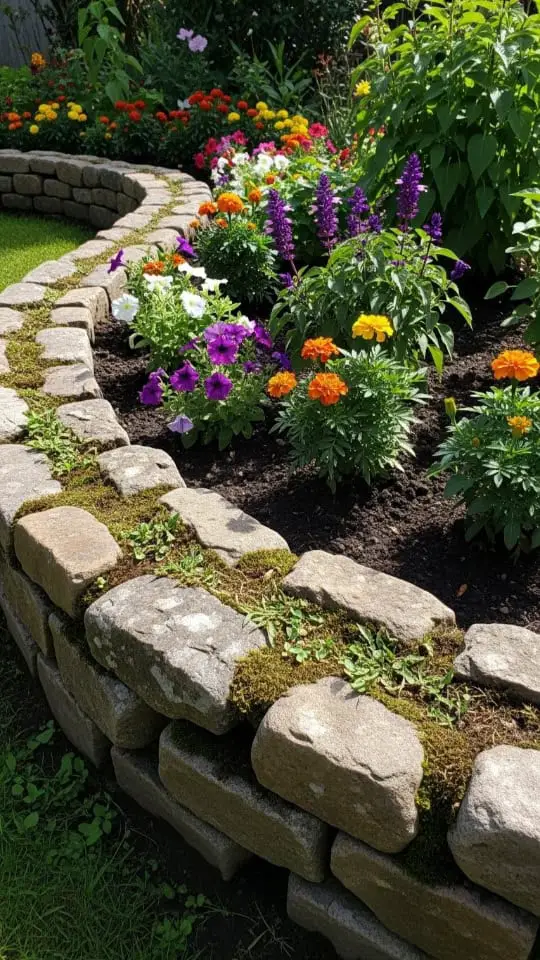
Timber
Natural stones create timeless borders, but timber brings warmth and simplicity. I love using solid wood for garden edging. It adds charm while supporting raised beds.
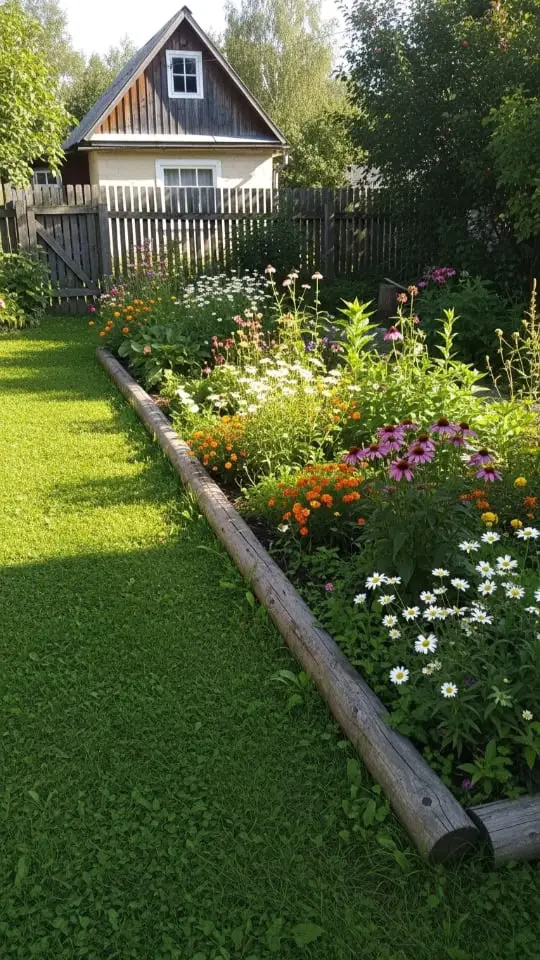
Timber blends well with any landscape design. It’s great for erosion prevention too. I often cut the wood into custom shapes to match my garden’s style.
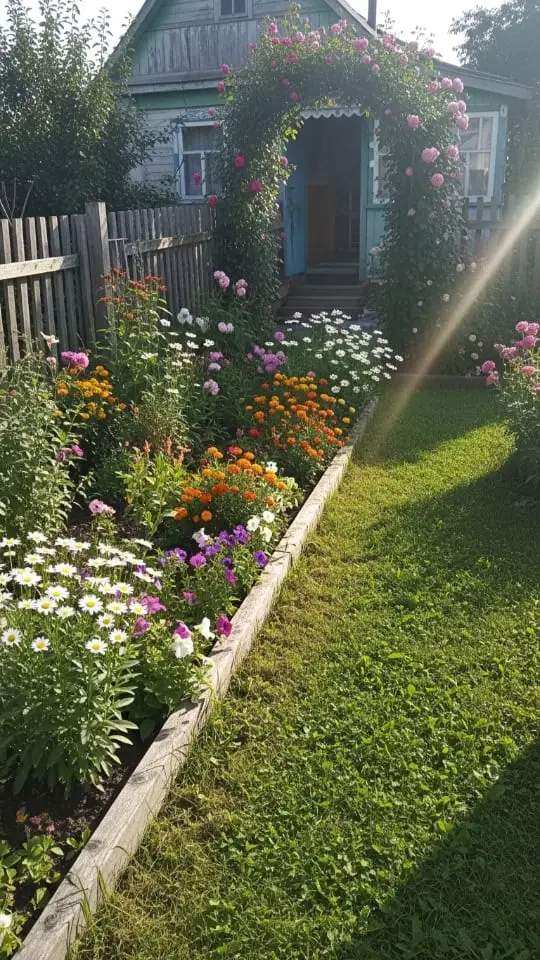
Sustainable sourcing makes it eco-friendly, which is a big win!
Tropical
Timber edging keeps things clean, but mossy stones bring a lush feeling. I love using them to surround large plants with tropical leaves.
The soft green moss blends right in with vibrant flowers and oversized bushes. It creates that vacation vibe like a resort garden.
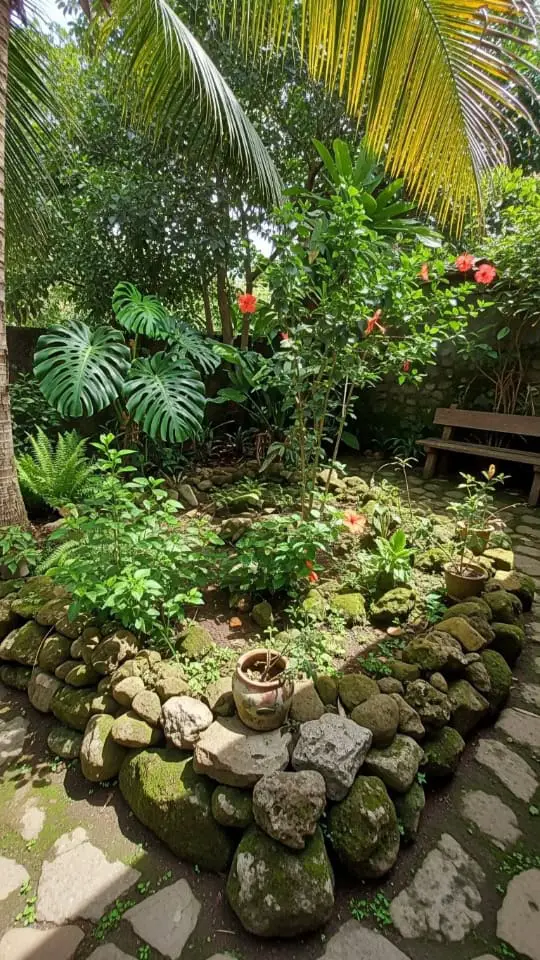
These stones fit perfectly into naturalistic designs without any fuss. They frame organic shapes well, enhancing curves instead of sharp lines.
Pairing them with bamboo furniture or tropical accessories completes the look. This low-maintenance edging feels alive and works beautifully in warm weather gardens too!
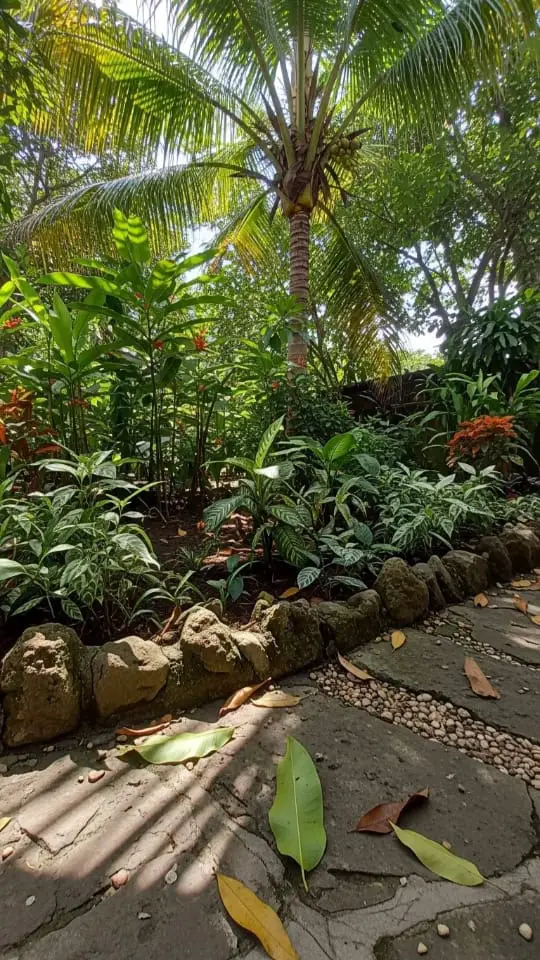
White
White borders bring gardens to life. They add a crisp, clean look that pops against green plants. These edges give flower beds and slopes structure, making everything feel tidy.
I find it works well with wood, stone, or even old timber for modern yet cheap edging ideas.
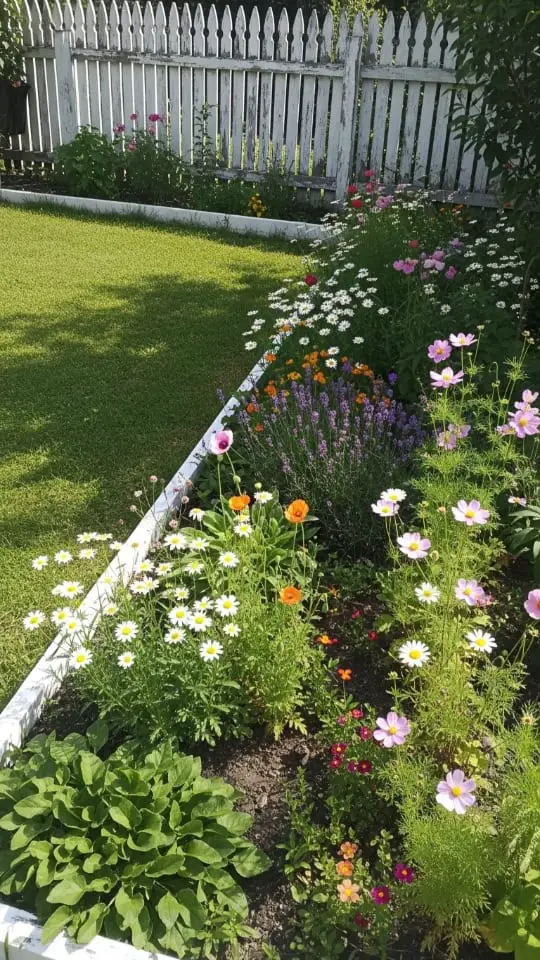
They suit both creative and classic garden designs. A fresh coat of paint on the borders feels like
The contrast between white and greenery makes every color in my garden stand out more brightly!

Willow
I love using woven willow for garden edging. It gives the yard a cozy, rustic feel. To make it, I use live willow whips about 2 meters long.
With some twine and secateurs, I tie them into arch shapes. This takes me around two hours to complete a neat border.
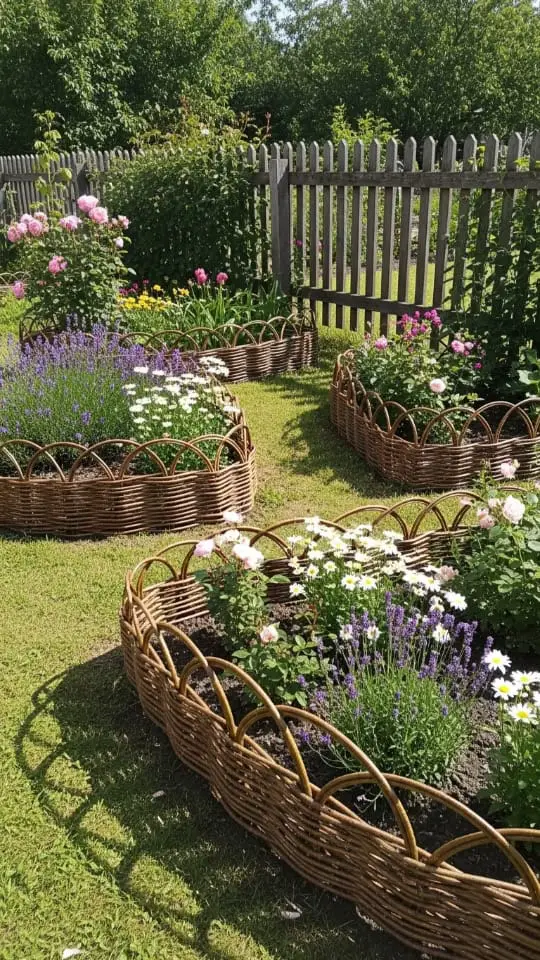
The best part is that living willow can sprout leaves in spring! Sometimes, I shape it into small arches or even fun sculptures. It does need care though since the plants keep growing over time.
For tools, all I really need are simple hand tools like pruning shears.
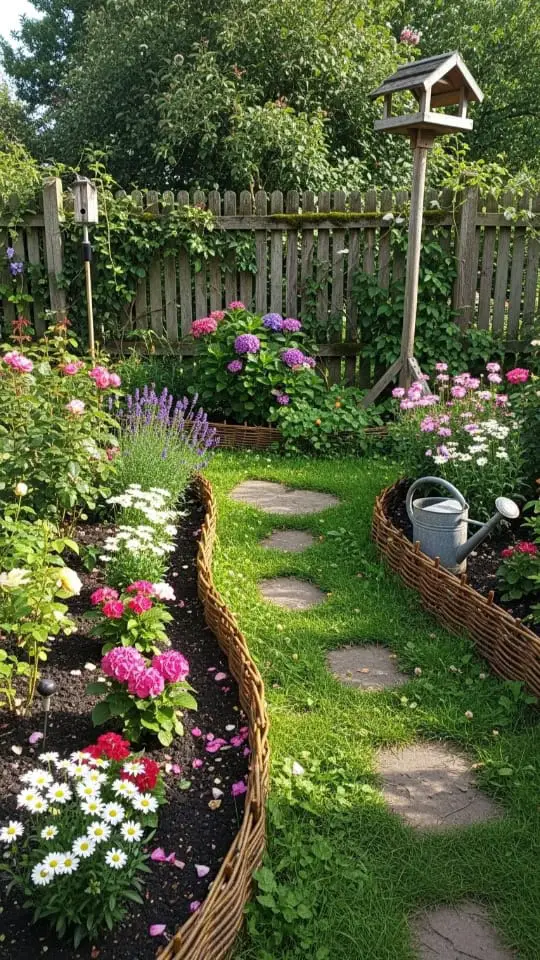
Wine Bottle
Willow edging adds charm, but wine bottles bring unique flair. I use colorful recycled wine bottles for borders. Green and cobalt blue are my favorites.
Friends, family, or local restaurants help me collect them.
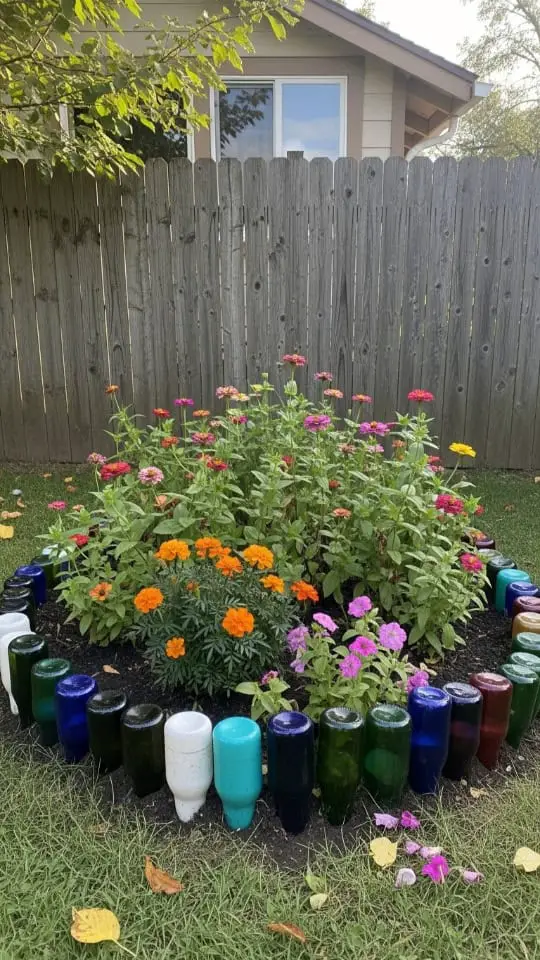
I bury each bottle upside down in a trench for stability. Small holes drilled at the bottom keep water from collecting inside.
The raised bed highlights upcycling while keeping flowers neatly contained. It’s creative and sustainable landscaping!

Wooden
Wooden planks make gardens feel cozy and natural. I like how they blend with the earth and plants around them.
Wood edging works great for raised beds, holding soil in place on slopes too.
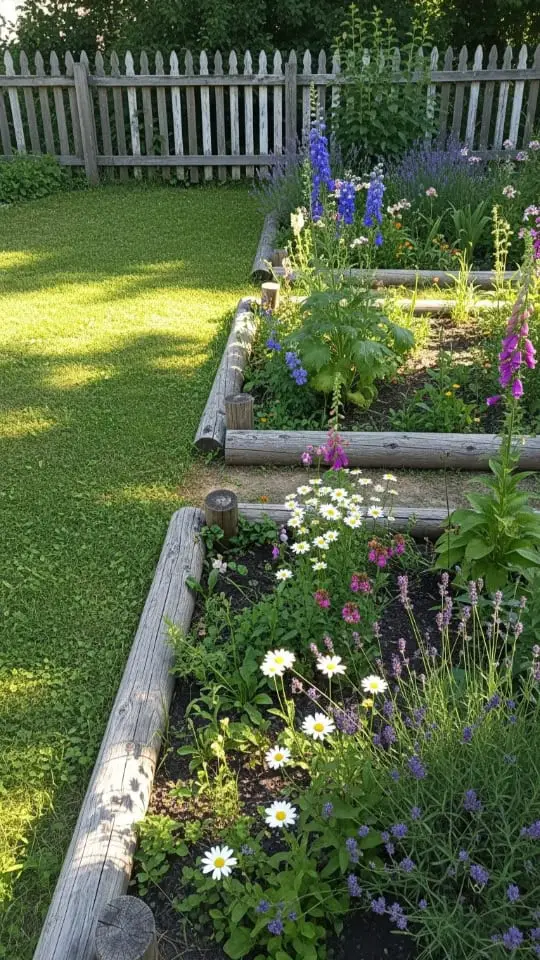
The planks can stay bare for a rustic look or get stained to match other wood details nearby. I’ve even seen some painted in bright colors for fun designs!
Using bamboo or rough branches also brings charm to spaces filled with flowers and shrubs. It’s simple but adds warmth.
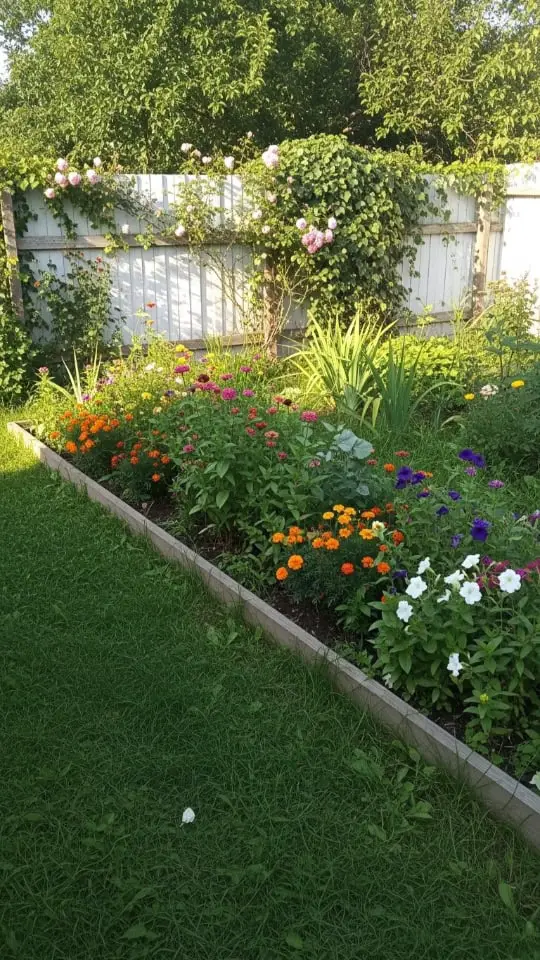
Conclusion
Picking the right garden edging makes a big difference. It frames your space, keeps it tidy, and boosts curb appeal. Whether you like bamboo, stone, or modern steel styles, there’s something for every taste.
Try one of these ideas to make your garden shine!
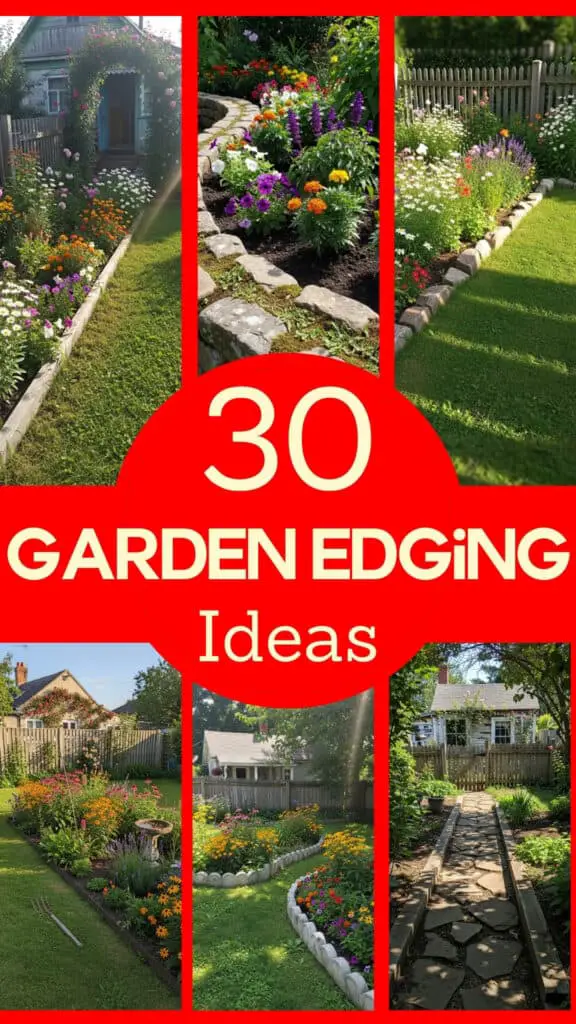
FAQs
1. What are some popular materials for garden edging?
Popular edging materials include stone, metal, recycled rubber edging, poured concrete, plastic, and landscape timbers.
2. How can I create low-maintenance garden edges?
Use options like recycled rubber or plastic edging. These require little upkeep and help with weed prevention and mulch containment.
3. Can I make my own DIY garden edging?
Yes! You can use railroad ties, corten steel pieces, or even cedar shake to add a personal touch to your yard.
4. What tools do I need for installing landscape edging?
You’ll likely need an edging shovel for digging and a rubber mallet to secure the material in place.
5. Which type of decorative edging works best for weed control?
Poured concrete or metal edging is great at keeping weeds out while adding clean lines to your garden beds.


